Essay Papers Writing Online
A comprehensive guide to crafting a successful comparison essay.

Comparison essays are a common assignment in academic settings, requiring students to analyze and contrast two or more subjects, concepts, or ideas. Writing a comparison essay can be challenging, but with the right approach and guidance, you can craft a compelling and informative piece of writing.
In this comprehensive guide, we will provide you with valuable tips and examples to help you master the art of comparison essay writing. Whether you’re comparing two literary works, historical events, scientific theories, or any other topics, this guide will equip you with the tools and strategies needed to create a well-structured and persuasive essay.
From choosing a suitable topic and developing a strong thesis statement to organizing your arguments and incorporating effective evidence, this guide will walk you through each step of the writing process. By following the advice and examples provided here, you’ll be able to produce a top-notch comparison essay that showcases your analytical skills and critical thinking abilities.

Understanding the Basics
Before diving into writing a comparison essay, it’s essential to understand the basics of comparison writing. A comparison essay, also known as a comparative essay, requires you to analyze two or more subjects by highlighting their similarities and differences. This type of essay aims to show how these subjects are similar or different in various aspects.
When writing a comparison essay, you should have a clear thesis statement that identifies the subjects you are comparing and the main points of comparison. It’s essential to structure your essay effectively by organizing your ideas logically. You can use different methods of organization, such as the block method or point-by-point method, to present your comparisons.
Additionally, make sure to include evidence and examples to support your comparisons. Use specific details and examples to strengthen your arguments and clarify the similarities and differences between the subjects. Lastly, remember to provide a strong conclusion that summarizes your main points and reinforces the significance of your comparison.
Choosing a Topic for Comparison Essay
When selecting a topic for your comparison essay, it’s essential to choose two subjects that have some similarities and differences to explore. You can compare two books, two movies, two historical figures, two theories, or any other pair of related subjects.
Consider selecting topics that interest you or that you are familiar with to make the writing process more engaging and manageable. Additionally, ensure that the subjects you choose are suitable for comparison and have enough material for analysis.
It’s also helpful to brainstorm ideas and create a list of potential topics before making a final decision. Once you have a few options in mind, evaluate them based on the relevance of the comparison, the availability of credible sources, and your own interest in the subjects.
Remember that a well-chosen topic is one of the keys to writing a successful comparison essay, so take your time to select subjects that will allow you to explore meaningful connections and differences in a compelling way.
Finding the Right Pairing
When writing a comparison essay, it’s crucial to find the right pairing of subjects to compare. Choose subjects that have enough similarities and differences to make a meaningful comparison. Consider the audience and purpose of your essay to determine what pairing will be most effective.
Look for subjects that you are passionate about or have a deep understanding of. This will make the writing process easier and more engaging. Additionally, consider choosing subjects that are relevant and timely, as this will make your essay more interesting to readers.
Don’t be afraid to think outside the box when finding the right pairing. Sometimes unexpected combinations can lead to the most compelling comparisons. Conduct thorough research on both subjects to ensure you have enough material to work with and present a balanced comparison.
Structuring Your Comparison Essay
When writing a comparison essay, it is essential to organize your ideas in a clear and logical manner. One effective way to structure your essay is to use a point-by-point comparison or a block comparison format.
Whichever format you choose, make sure to introduce your subjects, present your points of comparison, provide evidence or examples to support your comparisons, and conclude by summarizing the main points and highlighting the significance of your comparison.
Creating a Clear Outline
Before you start writing your comparison essay, it’s essential to create a clear outline. An outline serves as a roadmap that helps you stay organized and focused throughout the writing process. Here are some steps to create an effective outline:
1. Identify the subjects of comparison: Start by determining the two subjects you will be comparing in your essay. Make sure they have enough similarities and differences to make a meaningful comparison.
2. Brainstorm key points: Once you have chosen the subjects, brainstorm the key points you want to compare and contrast. These could include characteristics, features, themes, or arguments related to each subject.
3. Organize your points: Arrange your key points in a logical order. You can choose to compare similar points side by side or alternate between the two subjects to highlight differences.
4. Develop a thesis statement: Based on your key points, develop a clear thesis statement that states the main purpose of your comparison essay. This statement should guide the rest of your writing and provide a clear direction for your argument.
5. Create a structure: Divide your essay into introduction, body paragraphs, and conclusion. Each section should serve a specific purpose and contribute to the overall coherence of your essay.
By creating a clear outline, you can ensure that your comparison essay flows smoothly and effectively communicates your ideas to the reader.
Engaging the Reader
When writing a comparison essay, it is crucial to engage the reader right from the beginning. You want to hook their attention and make them want to keep reading. Here are some tips to engage your reader:
- Start with a strong opening statement or question that entices the reader to continue reading.
- Use vivid language and descriptive imagery to paint a clear picture in the reader’s mind.
- Provide interesting facts or statistics that pique the reader’s curiosity.
- Create a compelling thesis statement that outlines the purpose of your comparison essay.
By engaging the reader from the start, you set the stage for a successful and impactful comparison essay that keeps the reader engaged until the very end.
Point-by-Point vs Block Method

When writing a comparison essay, you have two main options for structuring your content: the point-by-point method and the block method. Each method has its own advantages and may be more suitable depending on the type of comparison you are making.
- Point-by-Point Method: This method involves discussing one point of comparison at a time between the two subjects. You will go back and forth between the subjects, highlighting similarities and differences for each point. This method allows for a more detailed and nuanced analysis of the subjects.
- Block Method: In contrast, the block method involves discussing all the points related to one subject first, followed by all the points related to the second subject. This method provides a more straightforward and organized comparison but may not delve as deeply into the individual points of comparison.
Ultimately, the choice between the point-by-point and block methods depends on the complexity of your comparison and the level of detail you want to explore. Experiment with both methods to see which one best suits your writing style and the specific requirements of your comparison essay.
Selecting the Best Approach
When it comes to writing a comparison essay, selecting the best approach is crucial to ensure a successful and effective comparison. There are several approaches you can take when comparing two subjects, including the block method and the point-by-point method.
The block method: This approach involves discussing all the similarities and differences of one subject first, followed by a thorough discussion of the second subject. This method is useful when the two subjects being compared are quite different or when the reader may not be familiar with one of the subjects.
The point-by-point method: This approach involves alternating between discussing the similarities and differences of the two subjects in each paragraph. This method allows for a more in-depth comparison of specific points and is often preferred when the two subjects have many similarities and differences.
Before selecting an approach, consider the nature of the subjects being compared and the purpose of your comparison essay. Choose the approach that will best serve your purpose and allow for a clear, organized, and engaging comparison.
Related Post
How to master the art of writing expository essays and captivate your audience, convenient and reliable source to purchase college essays online, step-by-step guide to crafting a powerful literary analysis essay, unlock success with a comprehensive business research paper example guide, unlock your writing potential with writers college – transform your passion into profession, “unlocking the secrets of academic success – navigating the world of research papers in college”, master the art of sociological expression – elevate your writing skills in sociology.

Comparing and Contrasting
What this handout is about.
This handout will help you first to determine whether a particular assignment is asking for comparison/contrast and then to generate a list of similarities and differences, decide which similarities and differences to focus on, and organize your paper so that it will be clear and effective. It will also explain how you can (and why you should) develop a thesis that goes beyond “Thing A and Thing B are similar in many ways but different in others.”
Introduction
In your career as a student, you’ll encounter many different kinds of writing assignments, each with its own requirements. One of the most common is the comparison/contrast essay, in which you focus on the ways in which certain things or ideas—usually two of them—are similar to (this is the comparison) and/or different from (this is the contrast) one another. By assigning such essays, your instructors are encouraging you to make connections between texts or ideas, engage in critical thinking, and go beyond mere description or summary to generate interesting analysis: when you reflect on similarities and differences, you gain a deeper understanding of the items you are comparing, their relationship to each other, and what is most important about them.
Recognizing comparison/contrast in assignments
Some assignments use words—like compare, contrast, similarities, and differences—that make it easy for you to see that they are asking you to compare and/or contrast. Here are a few hypothetical examples:
- Compare and contrast Frye’s and Bartky’s accounts of oppression.
- Compare WWI to WWII, identifying similarities in the causes, development, and outcomes of the wars.
- Contrast Wordsworth and Coleridge; what are the major differences in their poetry?
Notice that some topics ask only for comparison, others only for contrast, and others for both.
But it’s not always so easy to tell whether an assignment is asking you to include comparison/contrast. And in some cases, comparison/contrast is only part of the essay—you begin by comparing and/or contrasting two or more things and then use what you’ve learned to construct an argument or evaluation. Consider these examples, noticing the language that is used to ask for the comparison/contrast and whether the comparison/contrast is only one part of a larger assignment:
- Choose a particular idea or theme, such as romantic love, death, or nature, and consider how it is treated in two Romantic poems.
- How do the different authors we have studied so far define and describe oppression?
- Compare Frye’s and Bartky’s accounts of oppression. What does each imply about women’s collusion in their own oppression? Which is more accurate?
- In the texts we’ve studied, soldiers who served in different wars offer differing accounts of their experiences and feelings both during and after the fighting. What commonalities are there in these accounts? What factors do you think are responsible for their differences?
You may want to check out our handout on understanding assignments for additional tips.
Using comparison/contrast for all kinds of writing projects
Sometimes you may want to use comparison/contrast techniques in your own pre-writing work to get ideas that you can later use for an argument, even if comparison/contrast isn’t an official requirement for the paper you’re writing. For example, if you wanted to argue that Frye’s account of oppression is better than both de Beauvoir’s and Bartky’s, comparing and contrasting the main arguments of those three authors might help you construct your evaluation—even though the topic may not have asked for comparison/contrast and the lists of similarities and differences you generate may not appear anywhere in the final draft of your paper.
Discovering similarities and differences
Making a Venn diagram or a chart can help you quickly and efficiently compare and contrast two or more things or ideas. To make a Venn diagram, simply draw some overlapping circles, one circle for each item you’re considering. In the central area where they overlap, list the traits the two items have in common. Assign each one of the areas that doesn’t overlap; in those areas, you can list the traits that make the things different. Here’s a very simple example, using two pizza places:
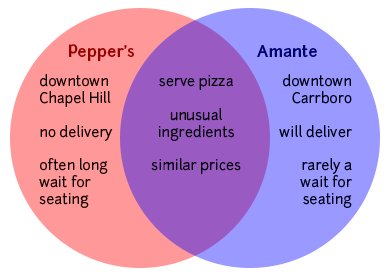
To make a chart, figure out what criteria you want to focus on in comparing the items. Along the left side of the page, list each of the criteria. Across the top, list the names of the items. You should then have a box per item for each criterion; you can fill the boxes in and then survey what you’ve discovered.
Here’s an example, this time using three pizza places:
As you generate points of comparison, consider the purpose and content of the assignment and the focus of the class. What do you think the professor wants you to learn by doing this comparison/contrast? How does it fit with what you have been studying so far and with the other assignments in the course? Are there any clues about what to focus on in the assignment itself?
Here are some general questions about different types of things you might have to compare. These are by no means complete or definitive lists; they’re just here to give you some ideas—you can generate your own questions for these and other types of comparison. You may want to begin by using the questions reporters traditionally ask: Who? What? Where? When? Why? How? If you’re talking about objects, you might also consider general properties like size, shape, color, sound, weight, taste, texture, smell, number, duration, and location.
Two historical periods or events
- When did they occur—do you know the date(s) and duration? What happened or changed during each? Why are they significant?
- What kinds of work did people do? What kinds of relationships did they have? What did they value?
- What kinds of governments were there? Who were important people involved?
- What caused events in these periods, and what consequences did they have later on?
Two ideas or theories
- What are they about?
- Did they originate at some particular time?
- Who created them? Who uses or defends them?
- What is the central focus, claim, or goal of each? What conclusions do they offer?
- How are they applied to situations/people/things/etc.?
- Which seems more plausible to you, and why? How broad is their scope?
- What kind of evidence is usually offered for them?
Two pieces of writing or art
- What are their titles? What do they describe or depict?
- What is their tone or mood? What is their form?
- Who created them? When were they created? Why do you think they were created as they were? What themes do they address?
- Do you think one is of higher quality or greater merit than the other(s)—and if so, why?
- For writing: what plot, characterization, setting, theme, tone, and type of narration are used?
- Where are they from? How old are they? What is the gender, race, class, etc. of each?
- What, if anything, are they known for? Do they have any relationship to each other?
- What are they like? What did/do they do? What do they believe? Why are they interesting?
- What stands out most about each of them?
Deciding what to focus on
By now you have probably generated a huge list of similarities and differences—congratulations! Next you must decide which of them are interesting, important, and relevant enough to be included in your paper. Ask yourself these questions:
- What’s relevant to the assignment?
- What’s relevant to the course?
- What’s interesting and informative?
- What matters to the argument you are going to make?
- What’s basic or central (and needs to be mentioned even if obvious)?
- Overall, what’s more important—the similarities or the differences?
Suppose that you are writing a paper comparing two novels. For most literature classes, the fact that they both use Caslon type (a kind of typeface, like the fonts you may use in your writing) is not going to be relevant, nor is the fact that one of them has a few illustrations and the other has none; literature classes are more likely to focus on subjects like characterization, plot, setting, the writer’s style and intentions, language, central themes, and so forth. However, if you were writing a paper for a class on typesetting or on how illustrations are used to enhance novels, the typeface and presence or absence of illustrations might be absolutely critical to include in your final paper.
Sometimes a particular point of comparison or contrast might be relevant but not terribly revealing or interesting. For example, if you are writing a paper about Wordsworth’s “Tintern Abbey” and Coleridge’s “Frost at Midnight,” pointing out that they both have nature as a central theme is relevant (comparisons of poetry often talk about themes) but not terribly interesting; your class has probably already had many discussions about the Romantic poets’ fondness for nature. Talking about the different ways nature is depicted or the different aspects of nature that are emphasized might be more interesting and show a more sophisticated understanding of the poems.
Your thesis
The thesis of your comparison/contrast paper is very important: it can help you create a focused argument and give your reader a road map so they don’t get lost in the sea of points you are about to make. As in any paper, you will want to replace vague reports of your general topic (for example, “This paper will compare and contrast two pizza places,” or “Pepper’s and Amante are similar in some ways and different in others,” or “Pepper’s and Amante are similar in many ways, but they have one major difference”) with something more detailed and specific. For example, you might say, “Pepper’s and Amante have similar prices and ingredients, but their atmospheres and willingness to deliver set them apart.”
Be careful, though—although this thesis is fairly specific and does propose a simple argument (that atmosphere and delivery make the two pizza places different), your instructor will often be looking for a bit more analysis. In this case, the obvious question is “So what? Why should anyone care that Pepper’s and Amante are different in this way?” One might also wonder why the writer chose those two particular pizza places to compare—why not Papa John’s, Dominos, or Pizza Hut? Again, thinking about the context the class provides may help you answer such questions and make a stronger argument. Here’s a revision of the thesis mentioned earlier:
Pepper’s and Amante both offer a greater variety of ingredients than other Chapel Hill/Carrboro pizza places (and than any of the national chains), but the funky, lively atmosphere at Pepper’s makes it a better place to give visiting friends and family a taste of local culture.
You may find our handout on constructing thesis statements useful at this stage.
Organizing your paper
There are many different ways to organize a comparison/contrast essay. Here are two:
Subject-by-subject
Begin by saying everything you have to say about the first subject you are discussing, then move on and make all the points you want to make about the second subject (and after that, the third, and so on, if you’re comparing/contrasting more than two things). If the paper is short, you might be able to fit all of your points about each item into a single paragraph, but it’s more likely that you’d have several paragraphs per item. Using our pizza place comparison/contrast as an example, after the introduction, you might have a paragraph about the ingredients available at Pepper’s, a paragraph about its location, and a paragraph about its ambience. Then you’d have three similar paragraphs about Amante, followed by your conclusion.
The danger of this subject-by-subject organization is that your paper will simply be a list of points: a certain number of points (in my example, three) about one subject, then a certain number of points about another. This is usually not what college instructors are looking for in a paper—generally they want you to compare or contrast two or more things very directly, rather than just listing the traits the things have and leaving it up to the reader to reflect on how those traits are similar or different and why those similarities or differences matter. Thus, if you use the subject-by-subject form, you will probably want to have a very strong, analytical thesis and at least one body paragraph that ties all of your different points together.
A subject-by-subject structure can be a logical choice if you are writing what is sometimes called a “lens” comparison, in which you use one subject or item (which isn’t really your main topic) to better understand another item (which is). For example, you might be asked to compare a poem you’ve already covered thoroughly in class with one you are reading on your own. It might make sense to give a brief summary of your main ideas about the first poem (this would be your first subject, the “lens”), and then spend most of your paper discussing how those points are similar to or different from your ideas about the second.
Point-by-point
Rather than addressing things one subject at a time, you may wish to talk about one point of comparison at a time. There are two main ways this might play out, depending on how much you have to say about each of the things you are comparing. If you have just a little, you might, in a single paragraph, discuss how a certain point of comparison/contrast relates to all the items you are discussing. For example, I might describe, in one paragraph, what the prices are like at both Pepper’s and Amante; in the next paragraph, I might compare the ingredients available; in a third, I might contrast the atmospheres of the two restaurants.
If I had a bit more to say about the items I was comparing/contrasting, I might devote a whole paragraph to how each point relates to each item. For example, I might have a whole paragraph about the clientele at Pepper’s, followed by a whole paragraph about the clientele at Amante; then I would move on and do two more paragraphs discussing my next point of comparison/contrast—like the ingredients available at each restaurant.
There are no hard and fast rules about organizing a comparison/contrast paper, of course. Just be sure that your reader can easily tell what’s going on! Be aware, too, of the placement of your different points. If you are writing a comparison/contrast in service of an argument, keep in mind that the last point you make is the one you are leaving your reader with. For example, if I am trying to argue that Amante is better than Pepper’s, I should end with a contrast that leaves Amante sounding good, rather than with a point of comparison that I have to admit makes Pepper’s look better. If you’ve decided that the differences between the items you’re comparing/contrasting are most important, you’ll want to end with the differences—and vice versa, if the similarities seem most important to you.
Our handout on organization can help you write good topic sentences and transitions and make sure that you have a good overall structure in place for your paper.
Cue words and other tips
To help your reader keep track of where you are in the comparison/contrast, you’ll want to be sure that your transitions and topic sentences are especially strong. Your thesis should already have given the reader an idea of the points you’ll be making and the organization you’ll be using, but you can help them out with some extra cues. The following words may be helpful to you in signaling your intentions:
- like, similar to, also, unlike, similarly, in the same way, likewise, again, compared to, in contrast, in like manner, contrasted with, on the contrary, however, although, yet, even though, still, but, nevertheless, conversely, at the same time, regardless, despite, while, on the one hand … on the other hand.
For example, you might have a topic sentence like one of these:
- Compared to Pepper’s, Amante is quiet.
- Like Amante, Pepper’s offers fresh garlic as a topping.
- Despite their different locations (downtown Chapel Hill and downtown Carrboro), Pepper’s and Amante are both fairly easy to get to.
You may reproduce it for non-commercial use if you use the entire handout and attribute the source: The Writing Center, University of North Carolina at Chapel Hill
Make a Gift
- Link to facebook
- Link to linkedin
- Link to twitter
- Link to youtube
- Writing Tips
Tips for Writing a Compare and Contrast Essay

5-minute read
- 19th August 2022
Compare and contrast essays are a specific form of academic essay with unique requirements, so if you’re a student , it’s important that you to know how to write one. Luckily, we’ve pieced together this guide to help you plan, structure, and put together your essay, complete with tips for comparing and contrasting.
Let’s begin.
1. What Is a Compare and Contrast Essay?
As you may have guessed, when writing a compare and contrast essay, you’ll need to do two things:
- Compare the similarities between two or more given subjects.
- Contrast their differences.
Compare and contrast essays are a common essay style because they allow your teacher or lecturer to assess your understanding of two theories, research methods, literary techniques, or other subjects. These subjects are usually related and may sometimes be confused with one another or are in conflict with each other.
By comparing and contrasting the subjects, you can also improve your analysis skills .
Some examples of compare and contrast essay titles include:
Compare and contrast a Shakespearean sonnet with a Petrarchan sonnet. What are the similarities and differences between anabolic and catabolic reactions? How were Nehru’s political beliefs similar to Gandhi’s? How did they differ?
2. Planning a Compare and Contrast Essay
As with any essay, before you begin writing, you should have a plan . In this case, you’ll first need to identify the similarities and differences between your subjects.
You can do this by writing out a list of all the qualities each subject possesses. Then, you can pick out any similar qualities that show up in both lists, and any qualities that are unique to just one of them. If you’re a visual learner, you might want to draw this as a Venn diagram .
Once you have all the similarities and differences prepared, consider which of them will be the most useful to include in your essay. Ask yourself:
- How much can you write about each point?
- What will your conclusion be, and which points support it?
- How will each point fit into your essay’s structure?
To answer that last question, let’s take a look at some ways to structure your essay.
Find this useful?
Subscribe to our newsletter and get writing tips from our editors straight to your inbox.
3. Structuring a Compare and Contrast Essay
Now that you’ve got a plan for your essay, it’s time to organize it. There are three main structures you can follow when writing a compare and contrast essay:
- The block structure: All of the information about one subject (e.g., Shakespearean sonnets) is presented in the first few paragraphs, followed by the subject it’s being compared and contrasted with (e.g., Petrarchan sonnets).
- The alternating structure: One similarity or difference between both subjects (e.g., rhyme scheme) is explored in one paragraph, followed by a paragraph on another similarity or difference (e.g., use of imagery), and so on.
- The similarities and differences structure: All the similarities between both subjects are presented, followed by the differences.
There are benefits to each of these structures. The block structure, for example, can be easier to write, while the alternating structure presents each similarity and difference clearly, and the similarities and differences structure focuses on those points rather than the subjects themselves.
So, when deciding which structure to use, consider what would work best for your essay. If you intend to cover each subject in detail, for example, you might want to choose the block structure.
On the other hand, if you want to emphasize the connections between each subject, the alternating structure might be best.
Finally, if you want to conclude that the subjects are either overwhelmingly similar or different to each other, the similarities and differences structure may work in your favor.
Whichever structure you follow, though, you’ll need to include a strong introduction and conclusion.
Your introduction should:
- Establish the subjects you will be comparing and contrasting.
- Provide some background about their connection (e.g., “Shakespearean and Petrarchan sonnets are poetic forms common in the 14th to 19th centuries”).
- Explain what you aim to achieve with your essay.
Meanwhile, your conclusion should:
- Summarize the main similarities and differences you have identified.
- Make a point regarding the relationship between your subjects.
4. Things to Remember
Here are some important tips to keep in mind when writing your compare and contrast essay:
- Ensure you are comparing or contrasting the same criteria between each subject. For example, it wouldn’t make sense to compare the line length of a Shakespearean sonnet with the rhyme scheme of a Petrarchan sonnet, as these are two separate categories.
- Always address both subjects of your essay in any introductions, conclusions, and topic sentences.
- Use comparison words and phrases such as “similarly,” “like,” and “in the same way” when comparing subjects.
- Use contrast words and phrases such as “in contrast,” “however,” and “whereas” when contrasting subjects.
- As with any essay, make sure to back up any arguments you make with evidence and credible sources .
Expert Academic Proofreading
Once you’ve written your compare and contrast essay, don’t forget to have it proofread. Our dedicated essay editing team is available 24/7 to help polish your paper. Try us out with a free proofreading and editing sample .
Share this article:
Post A New Comment
Got content that needs a quick turnaround? Let us polish your work. Explore our editorial business services.
Free email newsletter template.
Promoting a brand means sharing valuable insights to connect more deeply with your audience, and...
6-minute read
How to Write a Nonprofit Grant Proposal
If you’re seeking funding to support your charitable endeavors as a nonprofit organization, you’ll need...
9-minute read
How to Use Infographics to Boost Your Presentation
Is your content getting noticed? Capturing and maintaining an audience’s attention is a challenge when...
8-minute read
Why Interactive PDFs Are Better for Engagement
Are you looking to enhance engagement and captivate your audience through your professional documents? Interactive...
7-minute read
Seven Key Strategies for Voice Search Optimization
Voice search optimization is rapidly shaping the digital landscape, requiring content professionals to adapt their...
4-minute read
Five Creative Ways to Showcase Your Digital Portfolio
Are you a creative freelancer looking to make a lasting impression on potential clients or...

Make sure your writing is the best it can be with our expert English proofreading and editing.
Comparing and Contrasting: A Guide to Improve Your Essays

By Walter Akolo
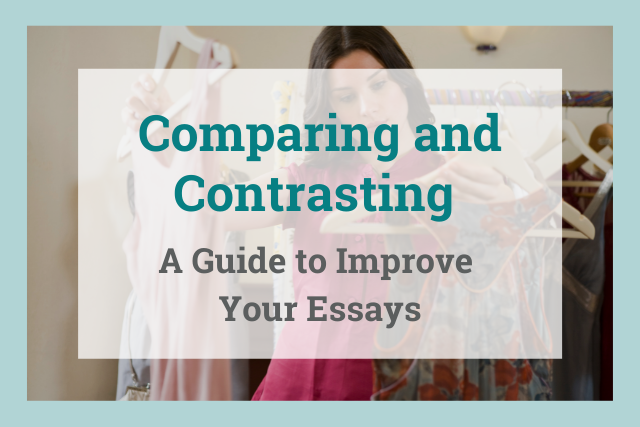
Essays that require you to compare and contrast two or more subjects, ideas, places, or items are common.
They call for you to highlight the key similarities (compare) and differences (contrast) between them.
This guide contains all the information you need to become better at writing comparing and contrasting essays.
This includes: how to structure your essay, how to decide on the content, and some examples of essay questions.
Let’s dive in.
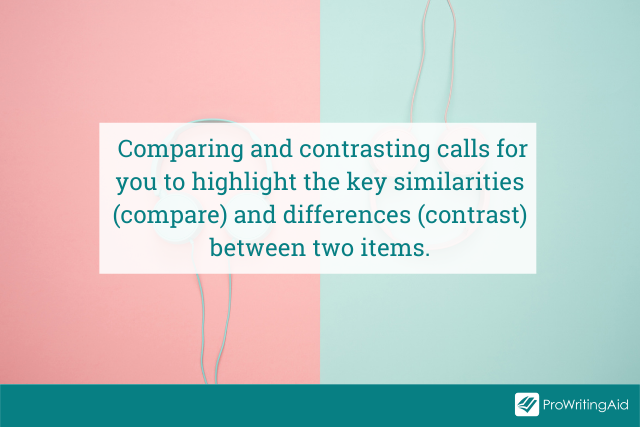
What Is Comparing and Contrasting?
Is compare and contrast the same as similarities and differences, what is the purpose of comparing and contrasting, can you compare and contrast any two items, how do you compare and contrast in writing, what are some comparing and contrasting techniques, how do you compare and contrast in college level writing, the four essentials of compare and contrast essays, what can you learn from a compare and contrast essay.
At their most basic, both comparing and contrasting base their evaluation on two or more subjects that share a connection.
The subjects could have similar characteristics, features, or foundations.
But while a comparison discusses the similarities of the two subjects, e.g. a banana and a watermelon are both fruit, contrasting highlights how the subjects or items differ from each other, e.g. a watermelon is around 10 times larger than a banana.
Any question that you are asked in education will have a variety of interesting comparisons and deductions that you can make.
Compare is the same as similarities.
Contrast is the same as differences.
This is because comparing identifies the likeness between two subjects, items, or categories, while contrasting recognizes disparities between them.
When you compare things, you represent them regarding their similarity, but when you contrast things, you define them in reference to their differences.
As a result, if you are asked to discuss the similarities and differences between two subjects, you can take an identical approach to if you are writing a compare and contrast essay.
In writing, the purpose of comparing and contrasting is to highlight subtle but important differences or similarities that might not be immediately obvious.
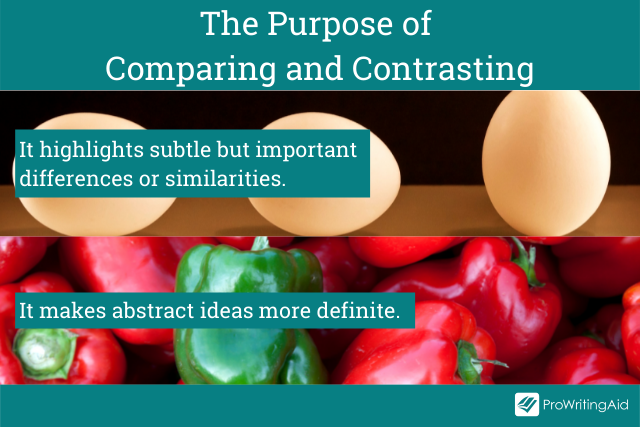
By illustrating the differences between elements in a similar category, you help heighten readers’ understanding of the subject or topic of discussion.
For instance, you might choose to compare and contrast red wine and white wine by pointing out the subtle differences. One of these differences is that red wine is best served at room temperature while white is best served chilled.
Also, comparing and contrasting helps to make abstract ideas more definite and minimizes the confusion that might exist between two related concepts.
Can Comparing and Contrasting Be Useful Outside of Academia?
Comparing enables you to see the pros and cons, allowing you to have a better understanding of the things under discussion. In an essay, this helps you demonstrate that you understand the nuances of your topic enough to draw meaningful conclusions from them.
Let's use a real-word example to see the benefits. Imagine you're contrasting two dresses you could buy. You might think:
- Dress A is purple, my favorite color, but it has a difficult zip and is practically impossible to match a jacket to.
- Dress B is more expensive but I already have a suitable pair of shoes and jacket and it is easier to move in.
You're linking the qualities of each dress to the context of the decision you're making. This is the same for your essay. Your comparison and contrast points will be in relation to the question you need to answer.
Comparing and contrasting is only a useful technique when applied to two related concepts.
To effectively compare two or more things, they must feature characteristics similar enough to warrant comparison.
In addition to this they must also feature a similarity that generates an interesting discussion. But what do I mean by “interesting” here?
Let’s look at two concepts, the Magna Carta and my third grade poetry competition entry.
They are both text, written on paper by a person so they fulfil the first requirement, they have a similarity. But this comparison clearly would not fulfil the second requirement, you would not be able to draw any interesting conclusions.
However, if we compare the Magna Carta to the Bill of Rights, you would be able to come to some very interesting conclusions concerning the history of world politics.
To write a good compare and contrast essay, it’s best to pick two or more topics that share a meaningful connection .
The aim of the essay would be to show the subtle differences or unforeseen similarities.
By highlighting the distinctions between elements in a similar category you can increase your readers’ understanding.
Alternatively, you could choose to focus on a comparison between two subjects that initially appear unrelated.
The more dissimilar they seem, the more interesting the comparison essay will turn out.
For instance, you could compare and contrast professional rugby players with marathon runners.
Can You Compare and Contrast in an Essay That Does Not Specifically Require It?
As a writer, you can employ comparing and contrasting techniques in your writing, particularly when looking for ideas you can later apply in your argument.
You can do this even when the comparison or contrast is not a requirement for the topic or argument you are presenting. Doing so could enable you to build your evaluation and develop a stronger argument.
Note that the similarities and differences you come up with might not even show up in the final draft.
While the use of compare and contrast can be neutral, you can also use it to highlight one option under discussion. When used this way, you can influence the perceived advantages of your preferred option.
As a writing style, comparing and contrasting can encompass an entire essay. However, it could also appear in some select paragraphs within the essay, where making some comparisons serves to better illustrate a point.
What Should You Do First?
Before you compare two things, always start by deciding on the reason for your comparison, then outline the criteria you will use to compare them.
Words and phrases commonly used for comparison include:

In writing, these words and phrases are called transitions . They help readers to understand or make the connection between sentences, paragraphs, and ideas.
Without transition words writing can feel clumsy and disjointed making it difficult to read. ProWritingAid’s transition report highlights all of a documents transitions and suggests that 25% of any sentences in a piece include a transition.

Sign up for a free ProWritingAid account to use the Transitions Report.
So, how do you form all of this into a coherent essay? It's a good idea to plan first, then decide what your paragraph layout will look like.
Venn diagrams are useful tool to start generating ideas. The, for your essay, you need to choose between going idea by idea and going point by point.
Using a Venn Diagram
A Venn diagram helps you to clearly see the similarities and differences between multiple objects, things, or subjects.
The writing tool comprises two, or more, simple, overlapping circles in which you list down the things that are alike (within the overlapping area) and those that differ (outside the overlapping area).
It’s great for brainstorming ideas and for creating your essay’s outline. You could even use it in an exam setting because it is quick and simple.
Going Subject by Subject
Going subject by subject is a structural choice for your essay.
Start by saying all you have to say on the first subject, then proceed to do the same about the second subject.
Depending on the length of your essay, you can fit the points about each subject into one paragraph or have several sections per each subject, ending with a conclusion.
This method is best for short essays on simple topics. Most university-level essays will go point by point instead.

Going Point by Point
Going point by point, or alternating, is the opposite essay structure from going subject by subject. This is ideal when you want to do more direct comparing and contrasting. It entails discussing one comparison point at a time. It allows you to use a paragraph to talk about how a certain comparing/contrasting point relates to the subjects or items you are discussing.
Alternatively, if you have lots of details about the subject, you might decide to use a paragraph for each point.
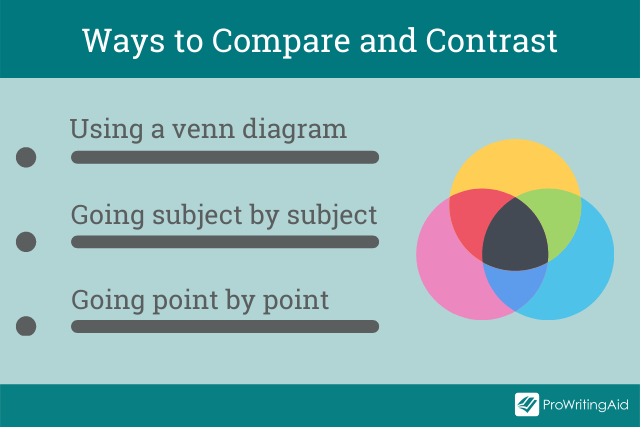
An academic compare and contrast essay looks at two or more subjects, ideas, people, or objects, compares their likeness, and contrasts their differences.
It’s an informative essay that provides insights on what is similar and different between the two items.
Depending on the essay’s instructions, you can focus solely on comparing or contrasting, or a combination of the two.
Examples of College Level Compare and Contrast Essay Questions
Here are eleven examples of compare and contrast essay questions that you might encounter at university:

- Archaeology: Compare and contrast the skulls of homo habilis, homo erectus, and homo sapiens.
- Art: Compare and contrast the working styles of any two Neoclassic artists.
- Astrophysics: Compare and contrast the chemical composition of Venus and Neptune.
- Biology: Compare and contrast the theories of Lamarck and Darwin.
- Business: Compare and contrast 2 or more business models within the agricultural industry.
- Creative writing: Compare and contrast free indirect discourse with epistolary styles.
- English Literature: Compare and contrast William Wordsworth with Robert Browning.
- Geography: Compare and contrast the benefit of solar panels with the benefit of wind turbines.
- History: Compare and contrast WWI to WWII with specific reference to the causes and outcomes.
- Medicine: Compare and contrast England’s health service with America’s health service.
- Psychology: Compare and contrast the behaviorist theory with the psychodynamic theory.
So, the key takeaways to keep in mind are:
Have a basis for comparison. The two things need to have enough in common to justify a discussion about their similarities and disparities.
Don’t go back and forth when using the block method. The best way to write your essay is to begin with a paragraph discussing all the facets of the first topic. Then, move on to another paragraph and talk through all the aspects of the second subject.
You can use both alternating and blocking techniques. Combining the two approaches is also an option. You can apply the alternating method in some paragraphs, then switch and use the block method. This method will help you offer a much deeper analysis of the subjects.
Have a reason for comparing the two things. Only select the points of comparison that resonate with your purpose.
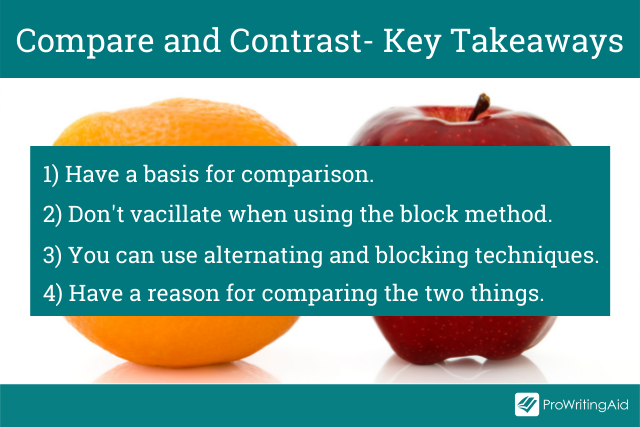
Comparing and contrasting are essential analytical skills in academic writing. When your professor issues you with such an essay, their primary goal is to teach you how to:
- Engage in critical thinking
- See and make connections between words or ideas
- Move beyond mere descriptions or summaries to developing interesting analysis
- Get a deeper understanding of the subjects or items under comparison, their key features, and their interrelationships with each other.
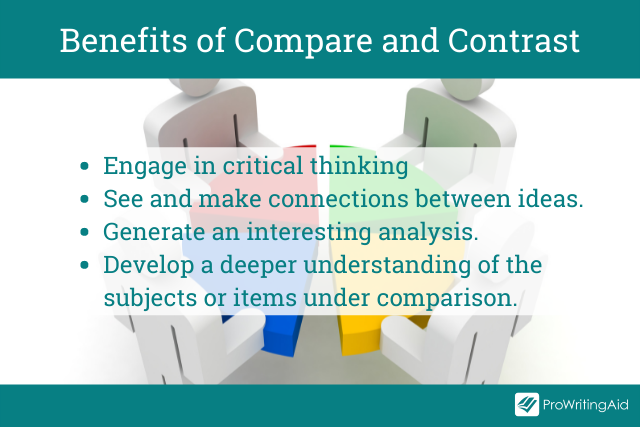
Ultimately, your essay should enlighten readers by providing useful information.
Want to use ProWritingAid with your classroom? Download this free book now:

ProWritingAid Teacher’s Manual
Editing technology like prowritingaid provides immediate, personalized feedback that will help students to better understand grammar and writing techniques., in this guide , we walk you through exactly how to use prowritingaid in your classroom and give you tools and templates for creating a rigorous, effective independent writing practice with your students..

Be confident about grammar
Check every email, essay, or story for grammar mistakes. Fix them before you press send.
Walter Akolo
Walter Akolo is a freelance writer, internet marketer, trainer, and blogger for hire. He loves helping businesses increase their reach and conversion through excellent and engaging content. He has gotten millions of pageviews on his blog, FreelancerKenya, where he mentors writers. Check out his website walterakolo.com.
Get started with ProWritingAid
Drop us a line or let's stay in touch via:
- Grades 6-12
- School Leaders
Give Students a Voice in This Digital Storytelling Competition!
34 Compelling Compare and Contrast Essay Examples
Topics cover education, technology, pop culture, sports, animals, and more.
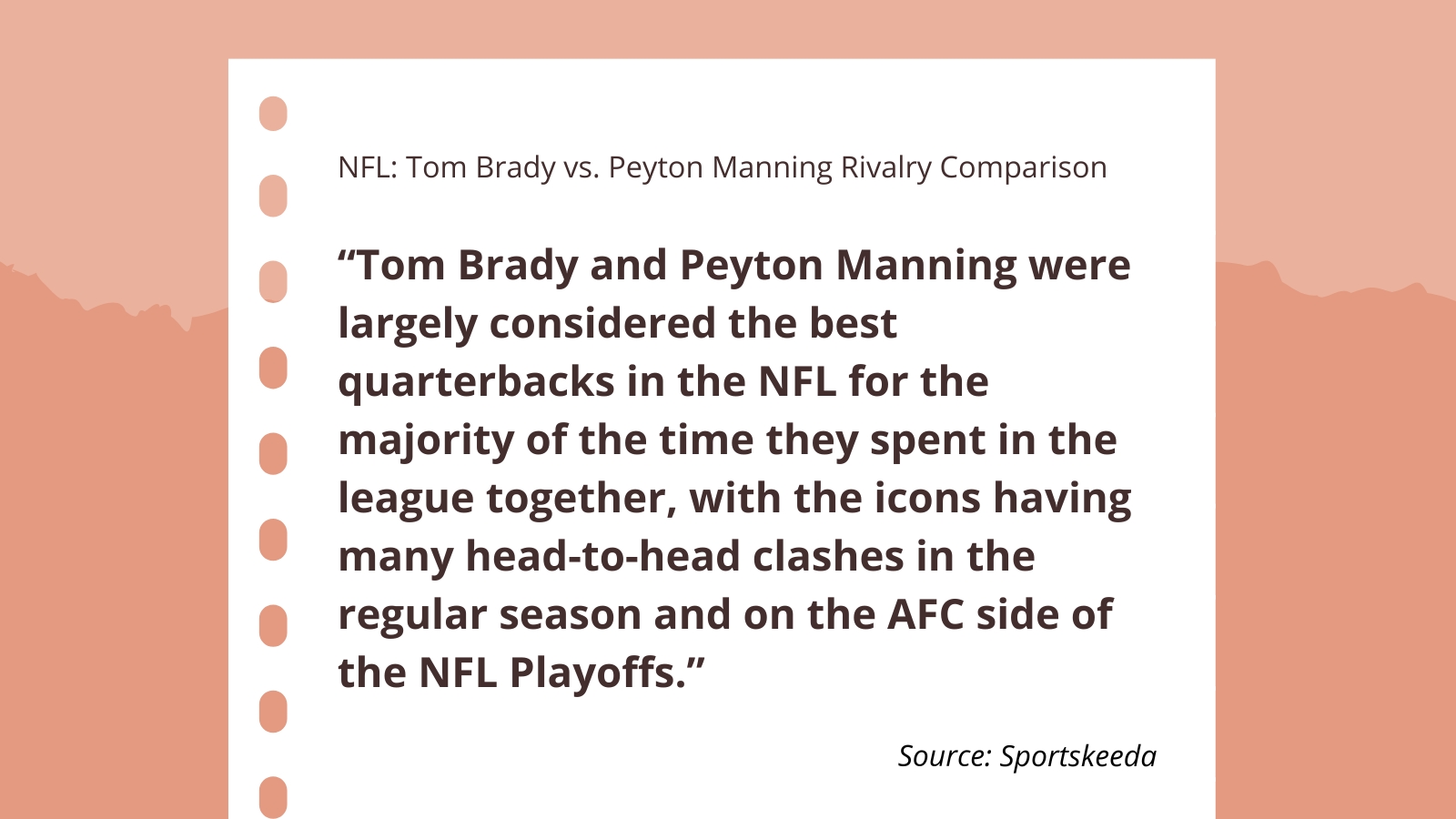
Do your writers need some inspiration? If you’re teaching students to write a compare and contrast essay, a strong example is an invaluable tool. This round-up of our favorite compare and contrast essays covers a range of topics and grade levels, so no matter your students’ interests or ages, you’ll always have a helpful example to share. You’ll find links to full essays about education, technology, pop culture, sports, animals, and more. (Need compare-and-contrast essay topic ideas? Check out our big list of compare and contrast essay topics! )
What is a compare and contrast essay?
- Education and parenting essays
- Technology essays
- Pop culture essays
- Historical and political essays
- Sports essays
- Lifestyle essays
- Healthcare essays
- Animal essays
When choosing a compare and contrast essay example to include on this list, we considered the structure. A strong compare and contrast essay begins with an introductory paragraph that includes background context and a strong thesis. Next, the body includes paragraphs that explore the similarities and differences. Finally, a concluding paragraph restates the thesis, draws any necessary inferences, and asks any remaining questions.
A compare and contrast essay example can be an opinion piece comparing two things and making a conclusion about which is better. For example, “Is Tom Brady really the GOAT?” It can also help consumers decide which product is better suited to them. Should you keep your subscription to Hulu or Netflix? Should you stick with Apple or explore Android? Here’s our list of compare and contrast essay samples categorized by subject.
Education and Parenting Compare and Contrast Essay Examples
Private school vs. public school.
Sample lines: “Deciding whether to send a child to public or private school can be a tough choice for parents. … Data on whether public or private education is better can be challenging to find and difficult to understand, and the cost of private school can be daunting. … According to the most recent data from the National Center for Education Statistics, public schools still attract far more students than private schools, with 50.7 million students attending public school as of 2018. Private school enrollment in the fall of 2017 was 5.7 million students, a number that is down from 6 million in 1999.”
Read the full essay: Private School vs. Public School at U.S. News and World Report
Homeschool vs. Public School: How Home Schooling Will Change Public Education

Sample lines: “Home schooling, not a present threat to public education, is nonetheless one of the forces that will change it. If the high estimates of the number of children in home schools (1.2 million) is correct, then the home-schooling universe is larger than the New York City public school system and roughly the size of the Los Angeles and Chicago public school systems combined. … Critics charge that three things are wrong with home schooling: harm to students academically; harm to society by producing students who are ill-prepared to function as democratic citizens and participants in a modern economy; and harm to public education, making it more difficult for other parents to educate their children. … It is time to ask whether home schooling, charters, and vouchers should be considered parts of a broad repertoire of methods that we as a society use to educate our children.”
Read the full essay: Homeschool vs. Public School: How Home Schooling Will Change Public Education at Brookings
Which parenting style is right for you?
Sample lines: “The three main types of parenting are on a type of ‘sliding scale’ of parenting, with permissive parenting as the least strict type of parenting. Permissive parenting typically has very few rules, while authoritarian parenting is thought of as a very strict, rule-driven type of parenting.”
Read the full essay: What Is Authoritative Parenting? at Healthline ADVERTISEMENT
Masked Education? The Benefits and Burdens of Wearing Face Masks in Schools During the Pandemic
Sample lines: “Face masks can prevent the spread of the virus SARS-CoV-2. … However, covering the lower half of the face reduces the ability to communicate. Positive emotions become less recognizable, and negative emotions are amplified. Emotional mimicry, contagion, and emotionality in general are reduced and (thereby) bonding between teachers and learners, group cohesion, and learning—of which emotions are a major driver. The benefits and burdens of face masks in schools should be seriously considered and made obvious and clear to teachers and students.”
Read the full essay: Masked Education? The Benefits and Burdens of Wearing Face Masks in Schools During the Pandemic at National Library of Medicine
To Ban or Not: What Should We Really Make of Book Bans?
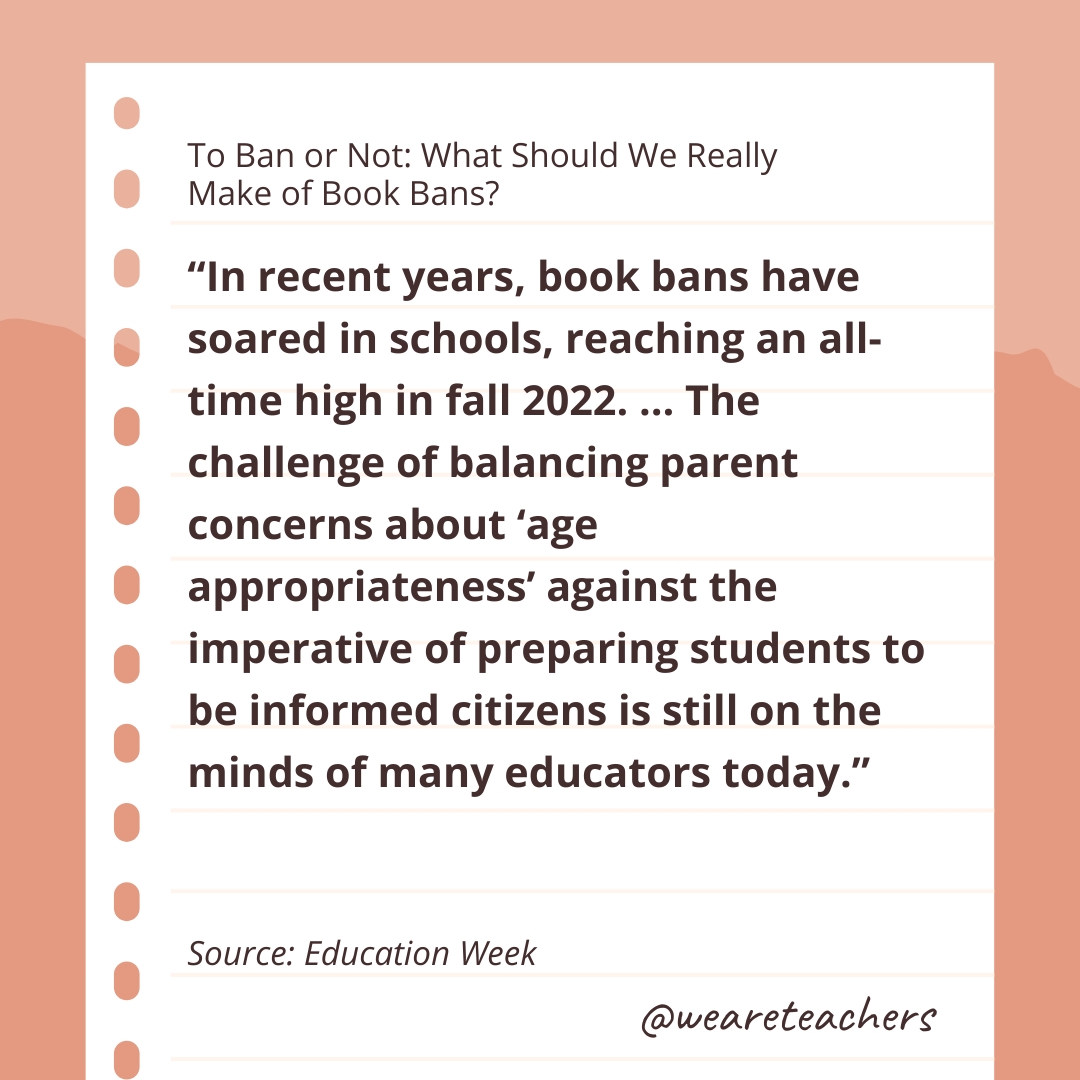
Sample lines: “In recent years, book bans have soared in schools, reaching an all-time high in fall 2022. … The challenge of balancing parent concerns about ‘age appropriateness’ against the imperative of preparing students to be informed citizens is still on the minds of many educators today. … Such curricular decision-making should be left to the professionals, argues English/language arts instructional specialist Miriam Plotinsky. ‘Examining texts for their appropriateness is not a job that noneducators are trained to do,’ she wrote last year, as the national debate over censorship resurged with the news that a Tennessee district banned the graphic novel Maus just days before Holocaust Remembrance Day.”
Read the full essay: To Ban or Not: What Should We Really Make of Book Bans? at Education Week
Technology Compare and Contrast Essay Examples
Netflix vs. hulu 2023: which is the best streaming service.
Sample lines: “Netflix fans will point to its high-quality originals, including The Witcher , Stranger Things , Emily in Paris , Ozark , and more, as well as a wide variety of documentaries like Cheer , The Last Dance , My Octopus Teacher , and many others. It also boasts a much larger subscription base, with more than 222 million subscribers compared to Hulu’s 44 million. Hulu, on the other hand, offers a variety of extras such as HBO and Showtime—content that’s unavailable on Netflix. Its price tag is also cheaper than the competition, with its $7/mo. starting price, which is a bit more palatable than Netflix’s $10/mo. starting price.”
Read the full essay: Netflix vs. Hulu 2023: Which is the best streaming service? at TV Guide
Kindle vs. Hardcover: Which is easier on the eyes?
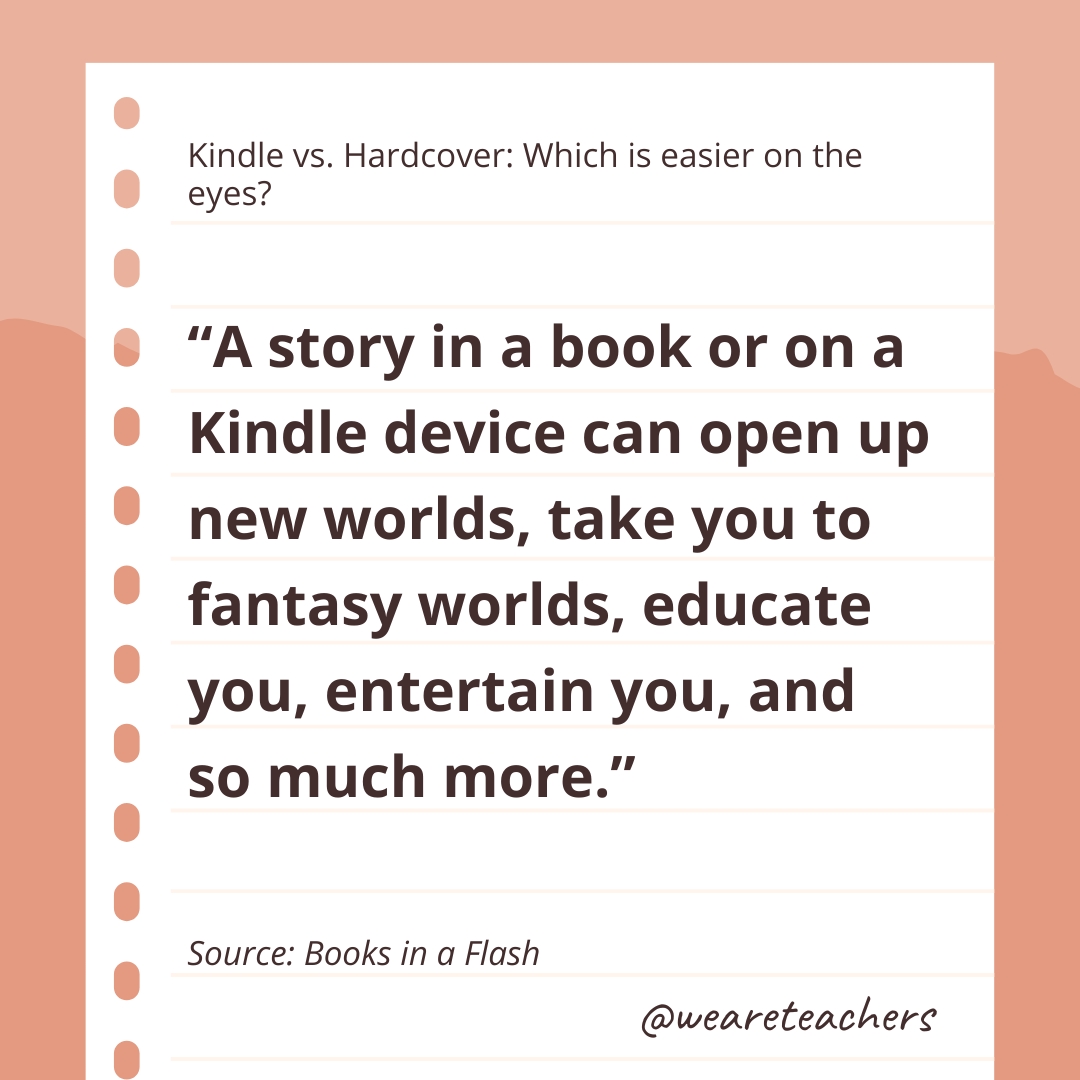
Sample lines: “In the past, we would have to drag around heavy books if we were really into reading. Now, we can have all of those books, and many more, stored in one handy little device that can easily be stuffed into a backpack, purse, etc. … Many of us still prefer to hold an actual book in our hands. … But, whether you use a Kindle or prefer hardcover books or paperbacks, the main thing is that you enjoy reading. A story in a book or on a Kindle device can open up new worlds, take you to fantasy worlds, educate you, entertain you, and so much more.”
Read the full essay: Kindle vs. Hardcover: Which is easier on the eyes? at Books in a Flash
iPhone vs. Android: Which is better for you?
Sample lines: “The iPhone vs. Android comparison is a never-ending debate on which one is best. It will likely never have a real winner, but we’re going to try and help you to find your personal pick all the same. iOS 17 and Android 14—the latest versions of the two operating systems—both offer smooth and user-friendly experiences, and several similar or identical features. But there are still important differences to be aware of. … Owning an iPhone is a simpler, more convenient experience. There’s less to think about. … Android-device ownership is a bit harder. … Yet it’s simultaneously more freeing, because it offers more choice.”
Read the full essay: iPhone vs. Android: Which is better for you? at Tom’s Guide
Cutting the cord: Is streaming or cable better for you?
Sample lines: “Cord-cutting has become a popular trend in recent years, thanks to the rise of streaming services. For those unfamiliar, cord cutting is the process of canceling your cable subscription and instead, relying on streaming platforms such as Netflix and Hulu to watch your favorite shows and movies. The primary difference is that you can select your streaming services à la carte while cable locks you in on a set number of channels through bundles. So, the big question is: should you cut the cord?”
Read the full essay: Cutting the cord: Is streaming or cable better for you? at BroadbandNow
PS5 vs. Nintendo Switch
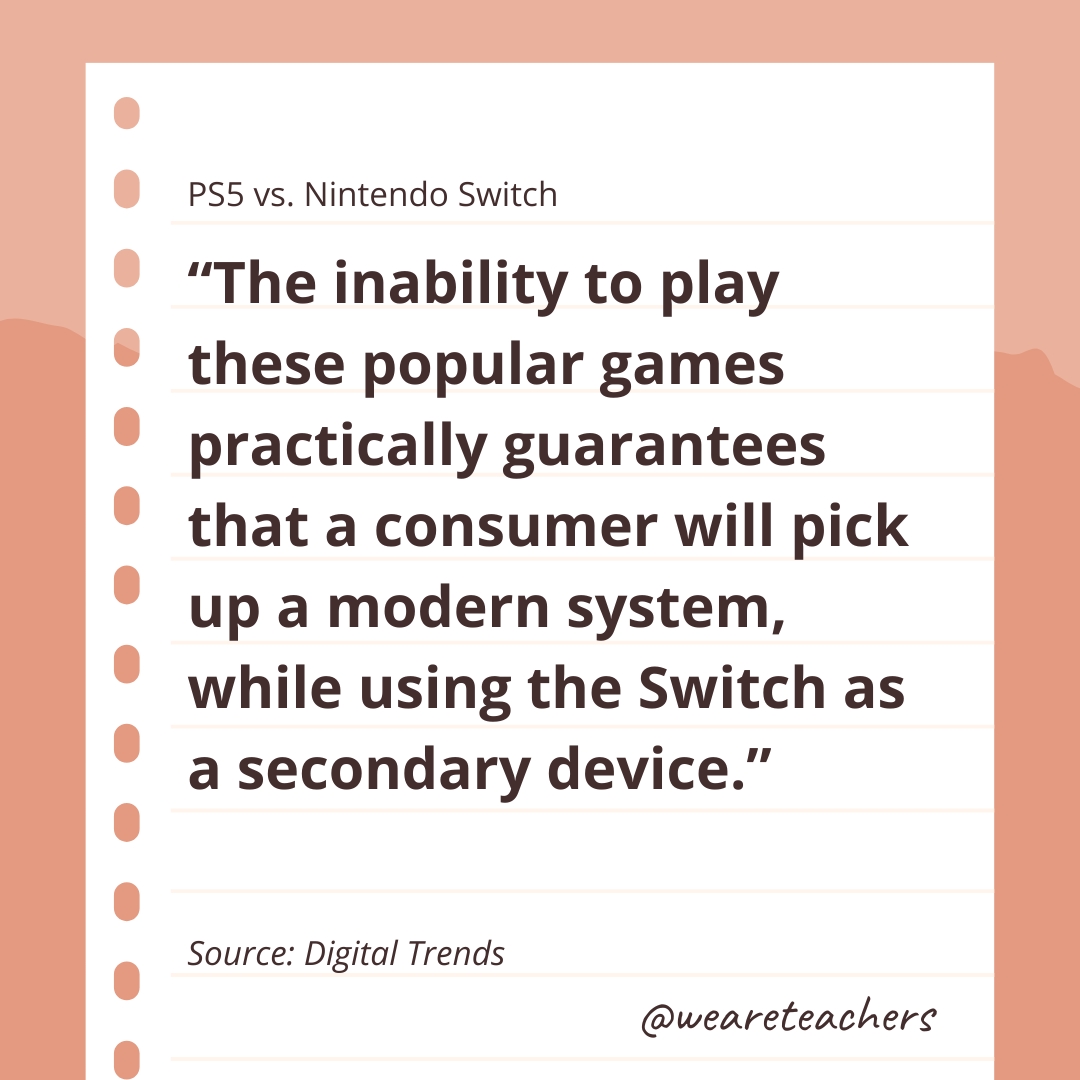
Sample lines: “The crux of the comparison comes down to portability versus power. Being able to migrate fully fledged Nintendo games from a big screen to a portable device is a huge asset—and one that consumers have taken to, especially given the Nintendo Switch’s meteoric sales figures. … It is worth noting that many of the biggest franchises like Call of Duty, Madden, modern Resident Evil titles, newer Final Fantasy games, Grand Theft Auto, and open-world Ubisoft adventures like Assassin’s Creed will usually skip Nintendo Switch due to its lack of power. The inability to play these popular games practically guarantees that a consumer will pick up a modern system, while using the Switch as a secondary device.”
Read the full essay: PS5 vs. Nintendo Switch at Digital Trends
What is the difference between Facebook and Instagram?
Sample lines: “Have you ever wondered what is the difference between Facebook and Instagram? Instagram and Facebook are by far the most popular social media channels used by digital marketers. Not to mention that they’re also the biggest platforms used by internet users worldwide. So, today we’ll look into the differences and similarities between these two platforms to help you figure out which one is the best fit for your business.”
Read the full essay: What is the difference between Facebook and Instagram? at SocialBee
Digital vs. Analog Watches—What’s the Difference?
Sample lines: “In short, digital watches use an LCD or LED screen to display the time. Whereas, an analog watch features three hands to denote the hour, minutes, and seconds. With the advancement in watch technology and research, both analog and digital watches have received significant improvements over the years. Especially in terms of design, endurance, and accompanying features. … At the end of the day, whether you go analog or digital, it’s a personal preference to make based on your style, needs, functions, and budget.”
Read the full essay: Digital vs. Analog Watches—What’s the Difference? at Watch Ranker
AI Art vs. Human Art: A Side-by-Side Analysis
Sample lines: “Art has always been a reflection of human creativity, emotion, and cultural expression. However, with the rise of artificial intelligence (AI), a new form of artistic creation has emerged, blurring the lines between what is created by human hands and what is generated by algorithms. … Despite the excitement surrounding AI Art, it also raises complex ethical, legal, and artistic questions that have sparked debates about the definition of art, the role of the artist, and the future of art production. … Regardless of whether AI Art is considered ‘true’ art, it is crucial to embrace and explore the vast possibilities and potential it brings to the table. The transformative influence of AI art on the art world is still unfolding, and only time will reveal its true extent.”
Read the full essay: AI Art vs. Human Art: A Side-by-Side Analysis at Raul Lara
Pop Culture Compare and Contrast Essay Examples
Christina aguilera vs. britney spears.
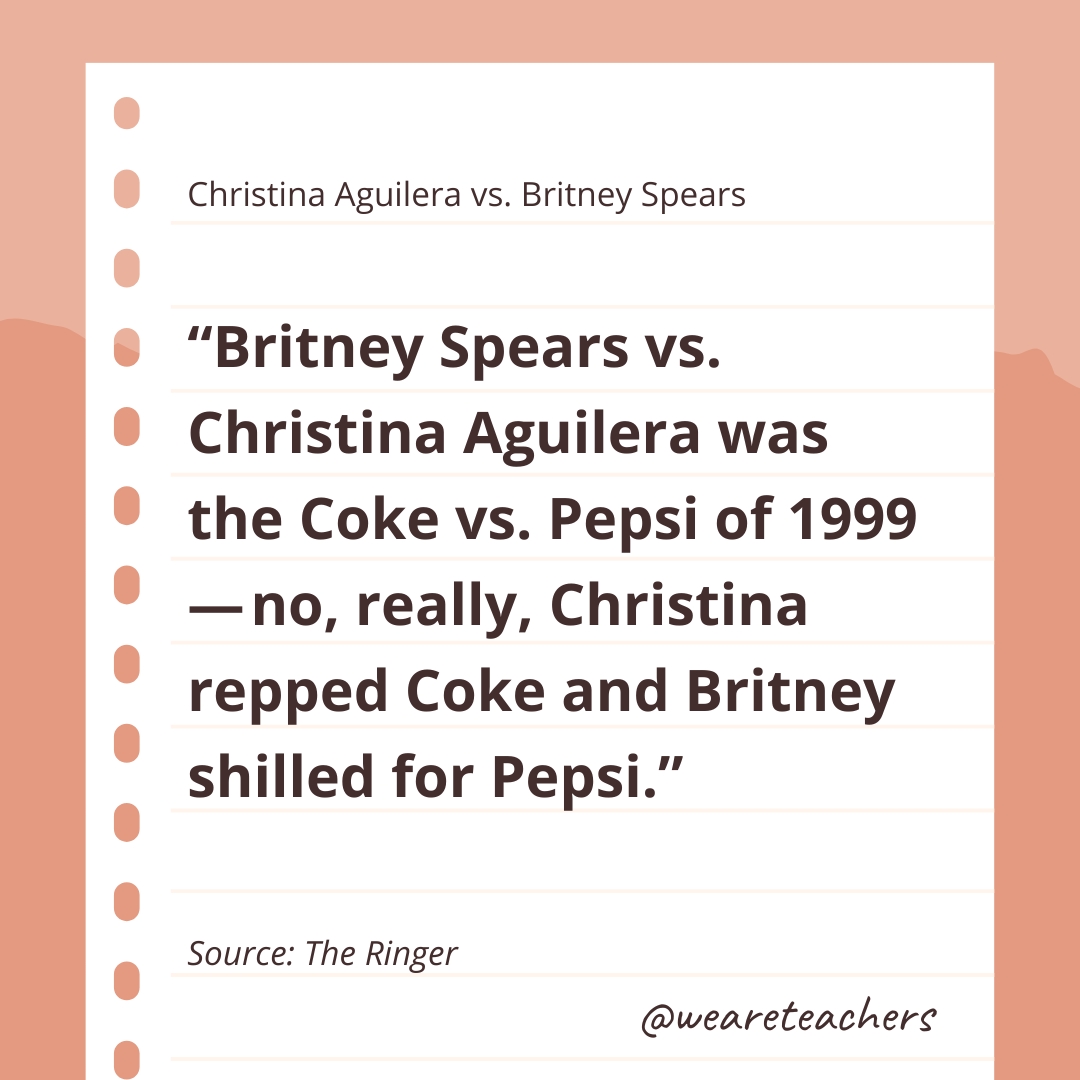
Sample lines: “Britney Spears vs. Christina Aguilera was the Coke vs. Pepsi of 1999 — no, really, Christina repped Coke and Britney shilled for Pepsi. The two teen idols released debut albums seven months apart before the turn of the century, with Britney’s becoming a standard-bearer for bubblegum pop and Aguilera’s taking an R&B bent to show off her range. … It’s clear that Spears and Aguilera took extremely divergent paths following their simultaneous breakout successes.”
Read the full essay: Christina Aguilera vs. Britney Spears at The Ringer
Harry Styles vs. Ed Sheeran
Sample lines: “The world heard our fantasies and delivered us two titans simultaneously—we have been blessed with Ed Sheeran and Harry Styles. Our cup runneth over; our bounty is immeasurable. More remarkable still is the fact that both have released albums almost at the same time: Ed’s third, Divide , was released in March and broke the record for one-day Spotify streams, while Harry’s frenziedly anticipated debut solo, called Harry Styles , was released yesterday.”
Read the full essay: Harry Styles versus Ed Sheeran at Belfast Telegraph
The Grinch: Three Versions Compared
Sample lines: “Based on the original story of the same name, this movie takes a completely different direction by choosing to break away from the cartoony form that Seuss had established by filming the movie in a live-action form. Whoville is preparing for Christmas while the Grinch looks down upon their celebrations in disgust. Like the previous film, The Grinch hatches a plan to ruin Christmas for the Who’s. … Like in the original Grinch, he disguises himself as Santa Claus, and makes his dog, Max, into a reindeer. He then takes all of the presents from the children and households. … Cole’s favorite is the 2000 edition, while Alex has only seen the original. Tell us which one is your favorite.”
Read the full essay: The Grinch: Three Versions Compared at Wooster School
Historical and Political Compare and Contrast Essay Examples
Malcolm x vs. martin luther king jr.: comparison between two great leaders’ ideologies .
Sample lines: “Although they were fighting for civil rights at the same time, their ideology and way of fighting were completely distinctive. This can be for a plethora of reasons: background, upbringing, the system of thought, and vision. But keep in mind, they devoted their whole life to the same prospect. … Through boycotts and marches, [King] hoped to end racial segregation. He felt that the abolition of segregation would improve the likelihood of integration. Malcolm X, on the other hand, spearheaded a movement for black empowerment.”
Read the full essay: Malcolm X vs. Martin Luther King Jr.: Comparison Between Two Great Leaders’ Ideologies at Melaninful
Contrast Between Obama and Trump Has Become Clear
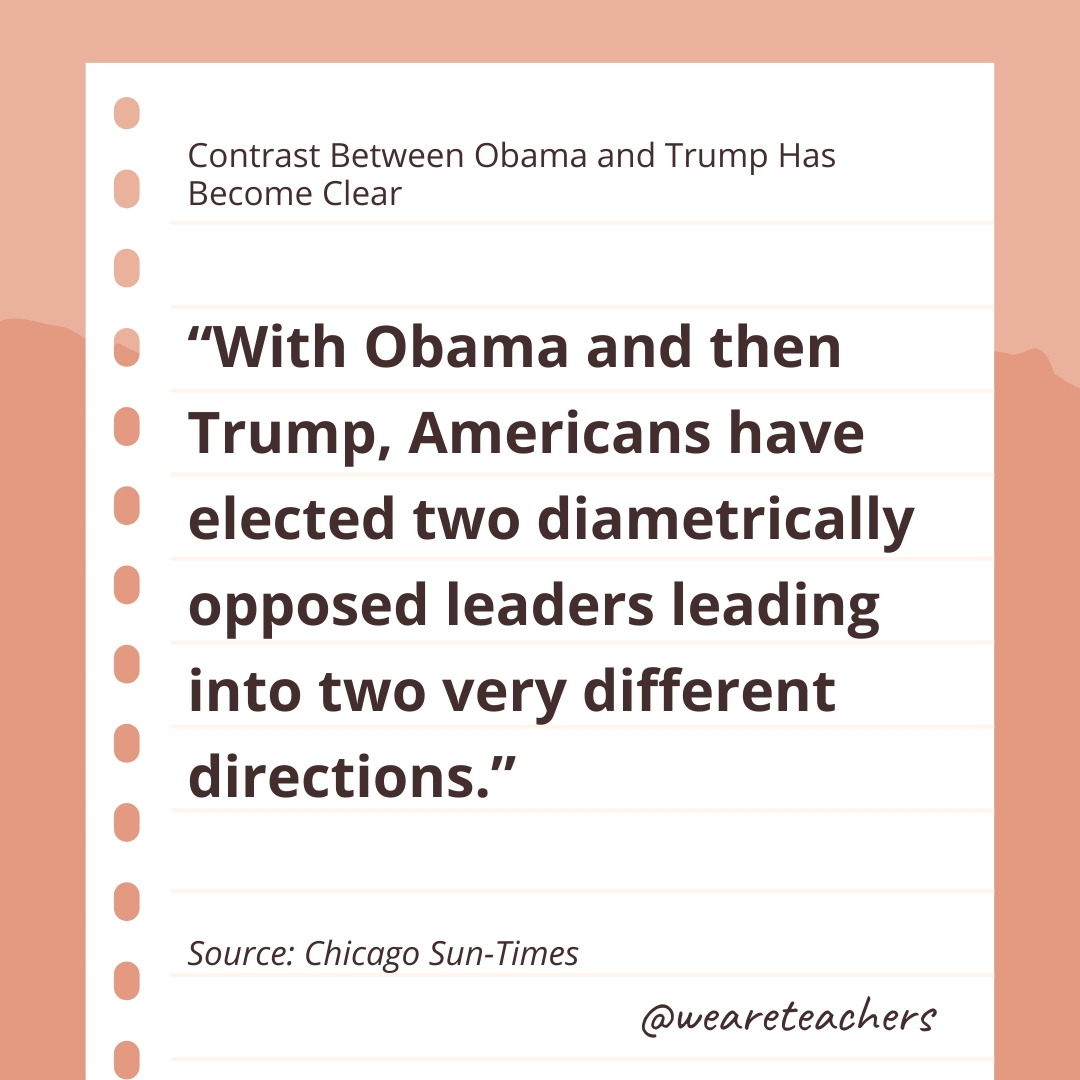
Sample lines: “The contrast is even clearer when we look to the future. Trump promises more tax cuts, more military spending, more deficits and deeper cuts in programs for the vulnerable. He plans to nominate a coal lobbyist to head the Environmental Protection Agency. … Obama says America must move forward, and he praises progressive Democrats for advocating Medicare for all. … With Obama and then Trump, Americans have elected two diametrically opposed leaders leading into two very different directions.”
Read the full essay: Contrast Between Obama and Trump Has Become Clear at Chicago Sun-Times
Sports Compare and Contrast Essay Examples
Lebron james vs. kobe bryant: a complete comparison.
Sample lines: “LeBron James has achieved so much in his career that he is seen by many as the greatest of all time, or at least the only player worthy of being mentioned in the GOAT conversation next to Michael Jordan. Bridging the gap between Jordan and LeBron though was Kobe Bryant, who often gets left out of comparisons and GOAT conversations. … Should his name be mentioned more though? Can he compare to LeBron or is The King too far past The Black Mamba in historical rankings already?”
Read the full essay: LeBron James vs. Kobe Bryant: A Complete Comparison at Sportskeeda
NFL: Tom Brady vs. Peyton Manning Rivalry Comparison
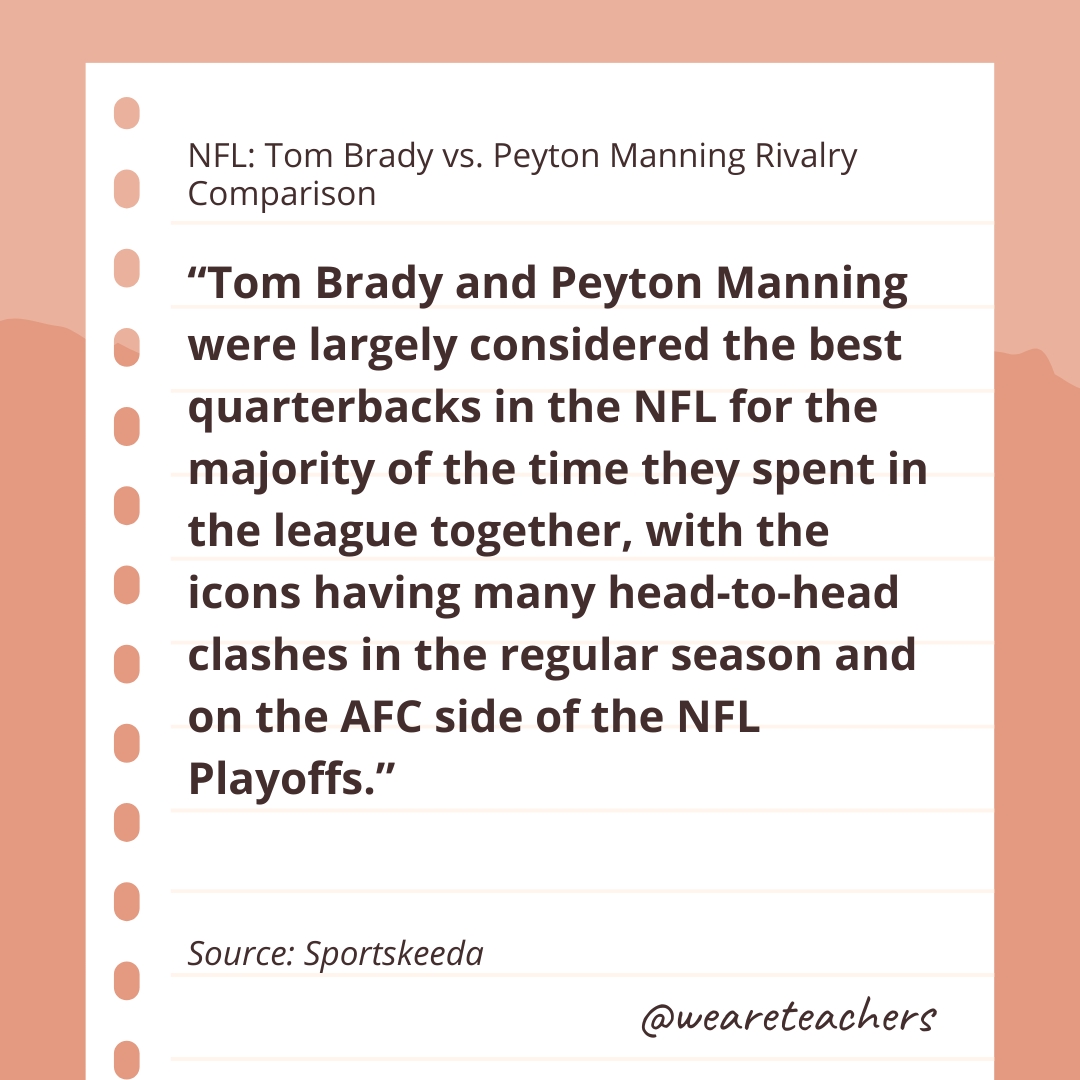
Sample lines: “Tom Brady and Peyton Manning were largely considered the best quarterbacks in the NFL for the majority of the time they spent in the league together, with the icons having many head-to-head clashes in the regular season and on the AFC side of the NFL Playoffs. Manning was the leader of the Indianapolis Colts of the AFC South. … Brady spent his career as the QB of the AFC East’s New England Patriots, before taking his talents to Tampa Bay. … The reality is that winning is the most important aspect of any career, and Brady won more head-to-head matchups than Manning did.”
Read the full essay: NFL: Tom Brady vs. Peyton Manning Rivalry Comparison at Sportskeeda
The Greatest NBA Franchise Ever: Boston Celtics or Los Angeles Lakers?
Sample lines: “The Celtics are universally considered as the greatest franchise in NBA history. But if you take a close look at the numbers, there isn’t really too much separation between them and their arch-rival Los Angeles Lakers. In fact, you can even make a good argument for the Lakers. … In 72 seasons played, the Boston Celtics have won a total of 3,314 games and lost 2,305 or a .590 winning mark. On the other hand, the Los Angeles Lakers have won 3,284 of 5,507 total games played or a slightly better winning record of .596. … But while the Lakers have the better winning percentage, the Celtics have the advantage over them in head-to-head competition.”
Read the full essay: The Greatest NBA Franchise Ever: Boston Celtics or Los Angeles Lakers? at Sport One
Is Soccer Better Than Football?
Sample lines: “Is soccer better than football? Soccer and football lovers have numerous reasons to support their sport of choice. Both keep the players physically fit and help to bring people together for an exciting cause. However, soccer has drawn more numbers globally due to its popularity in more countries.”
Read the full essay: Is Soccer Better Than Football? at Sports Brief
Lifestyle Choices Compare and Contrast Essay Examples
Mobile home vs. tiny house: similarities, differences, pros & cons.
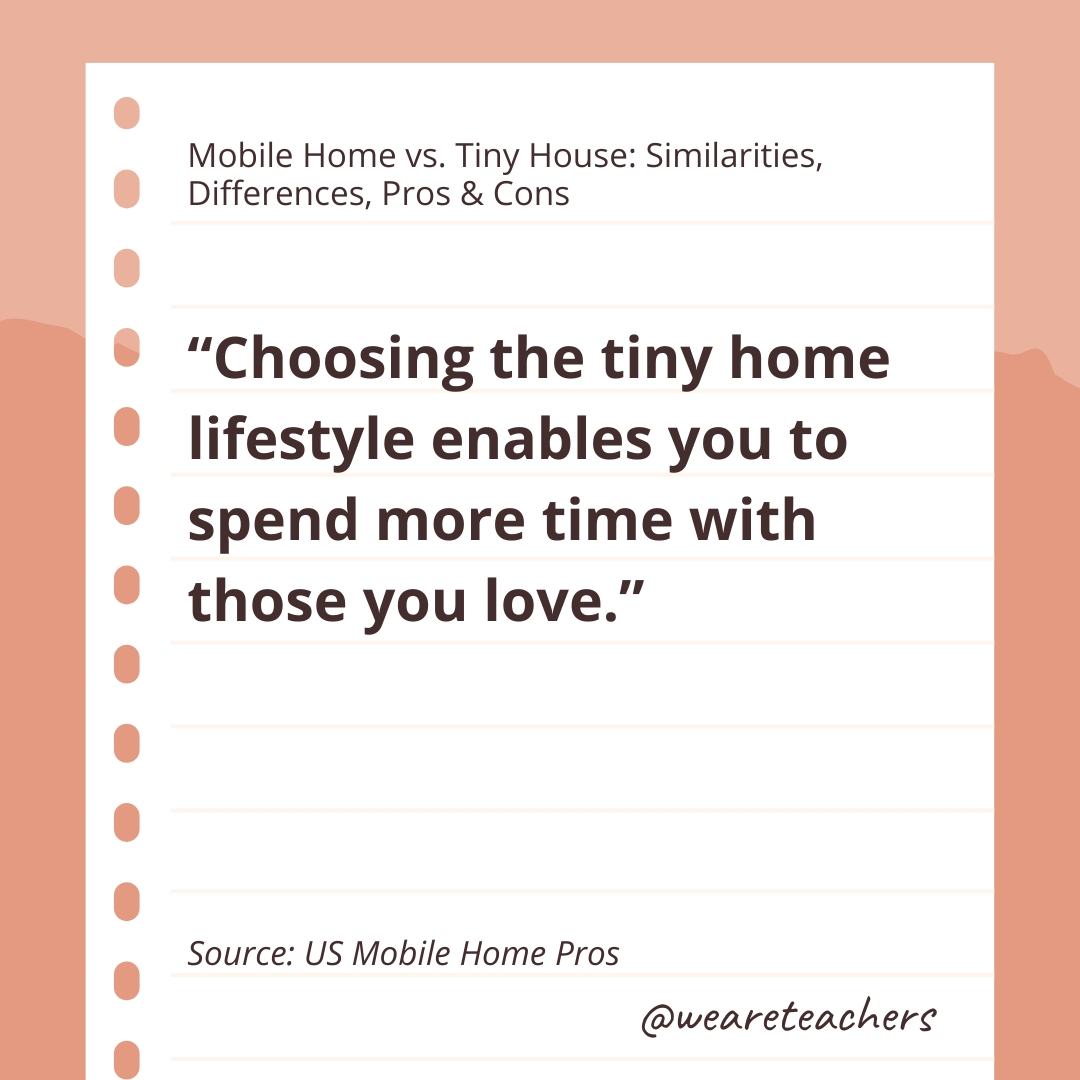
Sample lines: “Choosing the tiny home lifestyle enables you to spend more time with those you love. The small living space ensures quality bonding time rather than hiding away in a room or behind a computer screen. … You’ll be able to connect closer to nature and find yourself able to travel the country at any given moment. On the other hand, we have the mobile home. … They are built on a chassis with transportation in mind. … They are not built to be moved on a constant basis. … While moving the home again *is* possible, it may cost you several thousand dollars.”
Read the full essay: Mobile Home vs. Tiny House: Similarities, Differences, Pros & Cons at US Mobile Home Pros
Whole Foods vs. Walmart: The Story of Two Grocery Stores
Sample lines: “It is clear that both stores have very different stories and aims when it comes to their customers. Whole Foods looks to provide organic, healthy, exotic, and niche products for an audience with a very particular taste. … Walmart, on the other hand, looks to provide the best deals, every possible product, and every big brand for a broader audience. … Moreover, they look to make buying affordable and accessible, and focus on the capitalist nature of buying.”
Read the full essay: Whole Foods vs. Walmart: The Story of Two Grocery Stores at The Archaeology of Us
Artificial Grass vs. Turf: The Real Differences Revealed
Sample lines: “The key difference between artificial grass and turf is their intended use. Artificial turf is largely intended to be used for sports, so it is shorter and tougher. On the other hand, artificial grass is generally longer, softer and more suited to landscaping purposes. Most homeowners would opt for artificial grass as a replacement for a lawn, for example. Some people actually prefer playing sports on artificial grass, too … artificial grass is often softer and more bouncy, giving it a feel similar to playing on a grassy lawn. … At the end of the day, which one you will choose will depend on your specific household and needs.”
Read the full essay: Artificial Grass vs. Turf: The Real Differences Revealed at Almost Grass
Minimalism vs. Maximalism: Differences, Similarities, and Use Cases
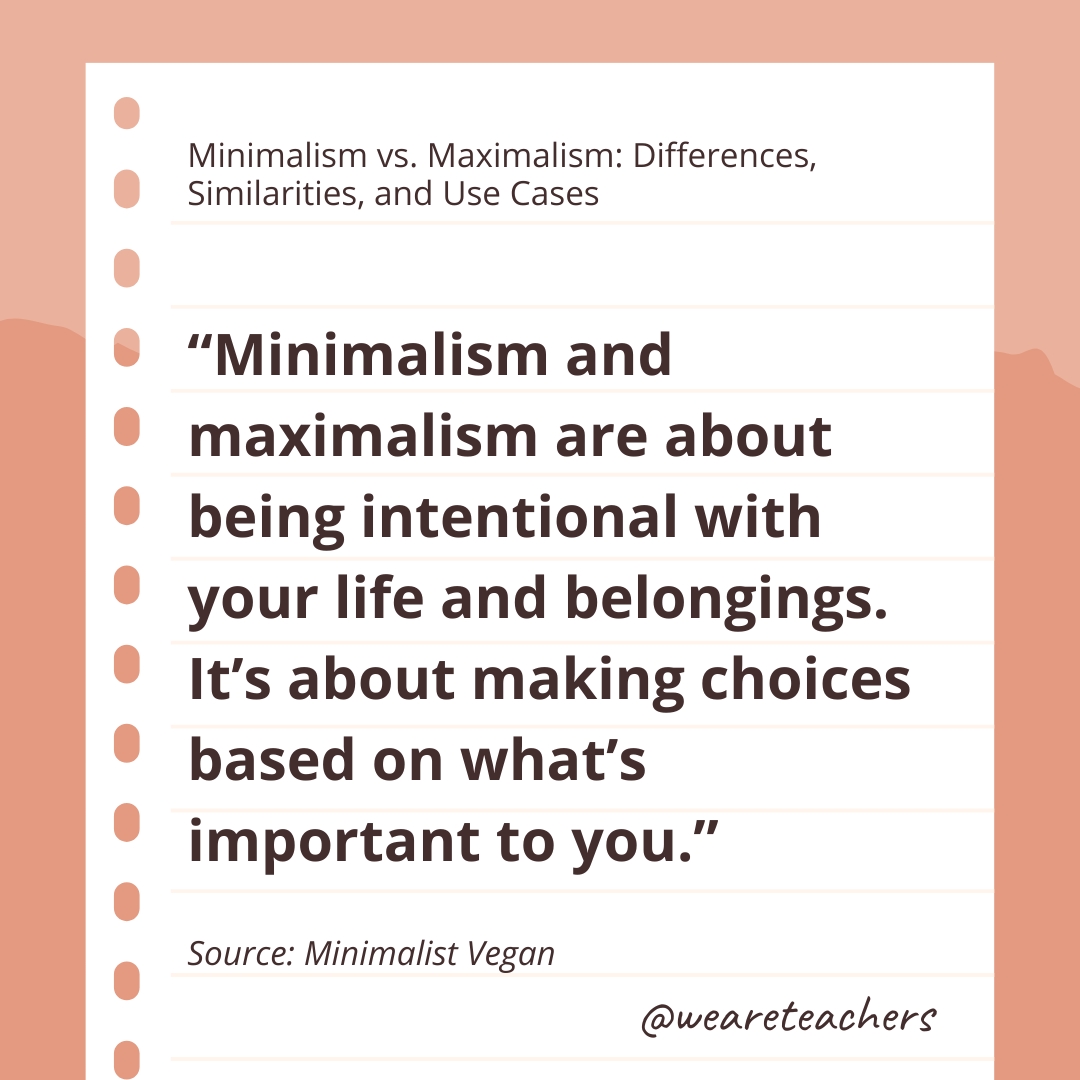
Sample lines: “Maximalists love shopping, especially finding unique pieces. They see it as a hobby—even a skill—and a way to express their personality. Minimalists don’t like shopping and see it as a waste of time and money. They’d instead use those resources to create memorable experiences. Maximalists desire one-of-a-kind possessions. Minimalists are happy with duplicates—for example, personal uniforms. … Minimalism and maximalism are about being intentional with your life and belongings. It’s about making choices based on what’s important to you.”
Read the full essay: Minimalism vs. Maximalism: Differences, Similarities, and Use Cases at Minimalist Vegan
Vegetarian vs. Meat Eating: Is It Better To Be a Vegetarian?
Sample lines: “You’ve heard buzz over the years that following a vegetarian diet is better for your health, and you’ve probably read a few magazine articles featuring a celeb or two who swore off meat and animal products and ‘magically’ lost weight. So does ditching meat automatically equal weight loss? Will it really help you live longer and be healthier overall? … Vegetarians appear to have lower low-density lipoprotein cholesterol levels, lower blood pressure and lower rates of hypertension and type 2 diabetes than meat eaters. Vegetarians also tend to have a lower body mass index, lower overall cancer rates and lower risk of chronic disease. But if your vegetarian co-worker is noshing greasy veggie burgers and fries every day for lunch, is he likely to be healthier than you, who always orders the grilled salmon? Definitely not!”
Read the full essay: Vegetarian vs. Meat Eating: Is It Better To Be a Vegetarian? at WebMD
Healthcare Compare and Contrast Essay Examples
Similarities and differences between the health systems in australia & usa.
Sample lines: “Australia and the United States are two very different countries. They are far away from each other, have contrasting fauna and flora, differ immensely by population, and have vastly different healthcare systems. The United States has a population of 331 million people, compared to Australia’s population of 25.5 million people.”
Read the full essay: Similarities and Differences Between the Health Systems in Australia & USA at Georgia State University
Universal Healthcare in the United States of America: A Healthy Debate
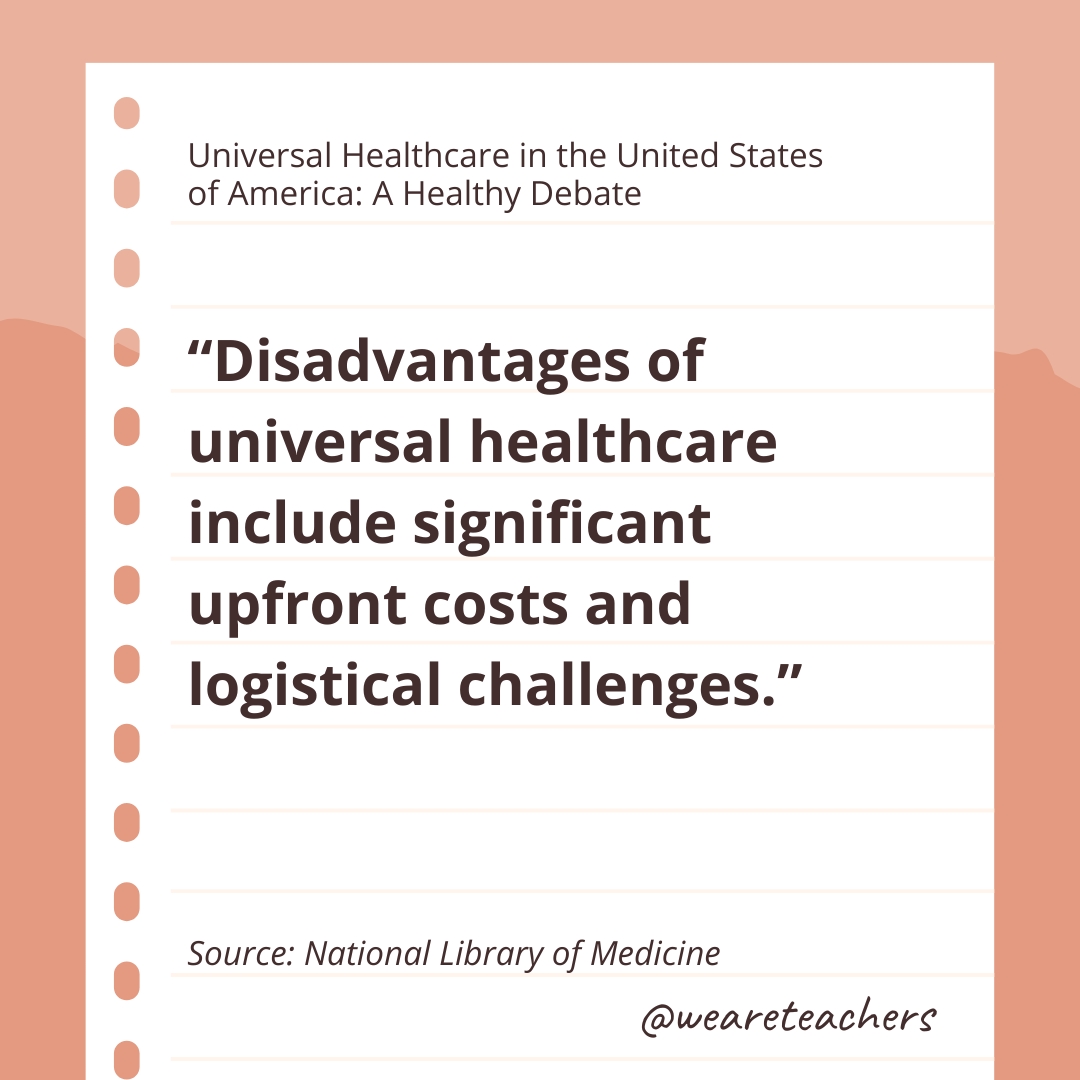
Sample lines: “Disadvantages of universal healthcare include significant upfront costs and logistical challenges. On the other hand, universal healthcare may lead to a healthier populace, and thus, in the long-term, help to mitigate the economic costs of an unhealthy nation. In particular, substantial health disparities exist in the United States, with low socio-economic status segments of the population subject to decreased access to quality healthcare and increased risk of non-communicable chronic conditions such as obesity and type II diabetes, among other determinants of poor health.”
Read the full essay: Universal Healthcare in the United States of America: A Healthy Debate at National Library of Medicine
Pros and Cons of Physician Aid in Dying
Sample lines: “Physician aid in dying is a controversial subject raising issues central to the role of physicians. … The two most common arguments in favor of legalizing AID are respect for patient autonomy and relief of suffering. A third, related, argument is that AID is a safe medical practice, requiring a health care professional. … Although opponents of AID offer many arguments ranging from pragmatic to philosophical, we focus here on concerns that the expansion of AID might cause additional, unintended harm through suicide contagion, slippery slope, and the deaths of patients suffering from depression.”
Read the full essay: Pros and Cons of Physician Aid in Dying at National Library of Medicine
Animals Compare and Contrast Essay Examples
Compare and contrast paragraph—dogs and cats.
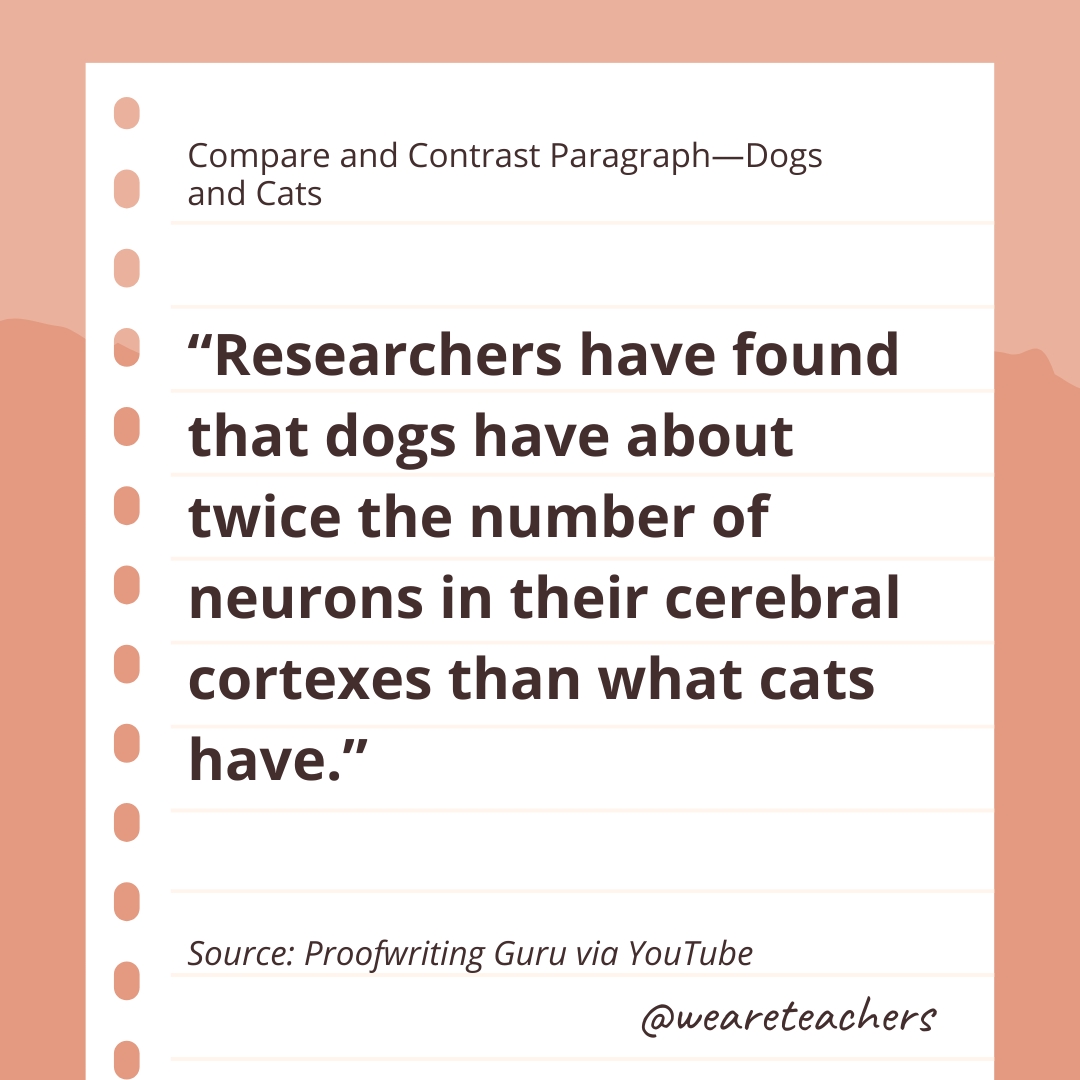
Sample lines: “Researchers have found that dogs have about twice the number of neurons in their cerebral cortexes than what cats have. Specifically, dogs had around 530 million neurons, whereas the domestic cat only had 250 million neurons. Moreover, dogs can be trained to learn and respond to our commands, but although your cat understands your name, and anticipates your every move, he/she may choose to ignore you.”
Read the full essay: Compare and Contrast Paragraph—Dogs and Cats at Proofwriting Guru via YouTube
Giddyup! The Differences Between Horses and Dogs
Sample lines: “Horses are prey animals with a deep herding instinct. They are highly sensitive to their environment, hyper aware, and ready to take flight if needed. Just like dogs, some horses are more confident than others, but just like dogs, all need a confident handler to teach them what to do. Some horses are highly reactive and can be spooked by the smallest things, as are dogs. … Another distinction between horses and dogs … was that while dogs have been domesticated , horses have been tamed. … Both species have influenced our culture more than any other species on the planet.”
Read the full essay: Giddyup! The Differences Between Horses and Dogs at Positively Victoria Stilwell
Exotic, Domesticated, and Wild Pets
Sample lines: “Although the words ‘exotic’ and ‘wild’ are frequently used interchangeably, many people do not fully understand how these categories differ when it comes to pets. ‘A wild animal is an indigenous, non-domesticated animal, meaning that it is native to the country where you are located,’ Blue-McLendon explained. ‘For Texans, white-tailed deer, pronghorn sheep, raccoons, skunks, and bighorn sheep are wild animals … an exotic animal is one that is wild but is from a different continent than where you live.’ For example, a hedgehog in Texas would be considered an exotic animal, but in the hedgehog’s native country, it would be considered wildlife.”
Read the full essay: Exotic, Domesticated, and Wild Pets at Texas A&M University
Should Zoos Be Banned? Pros & Cons of Zoos
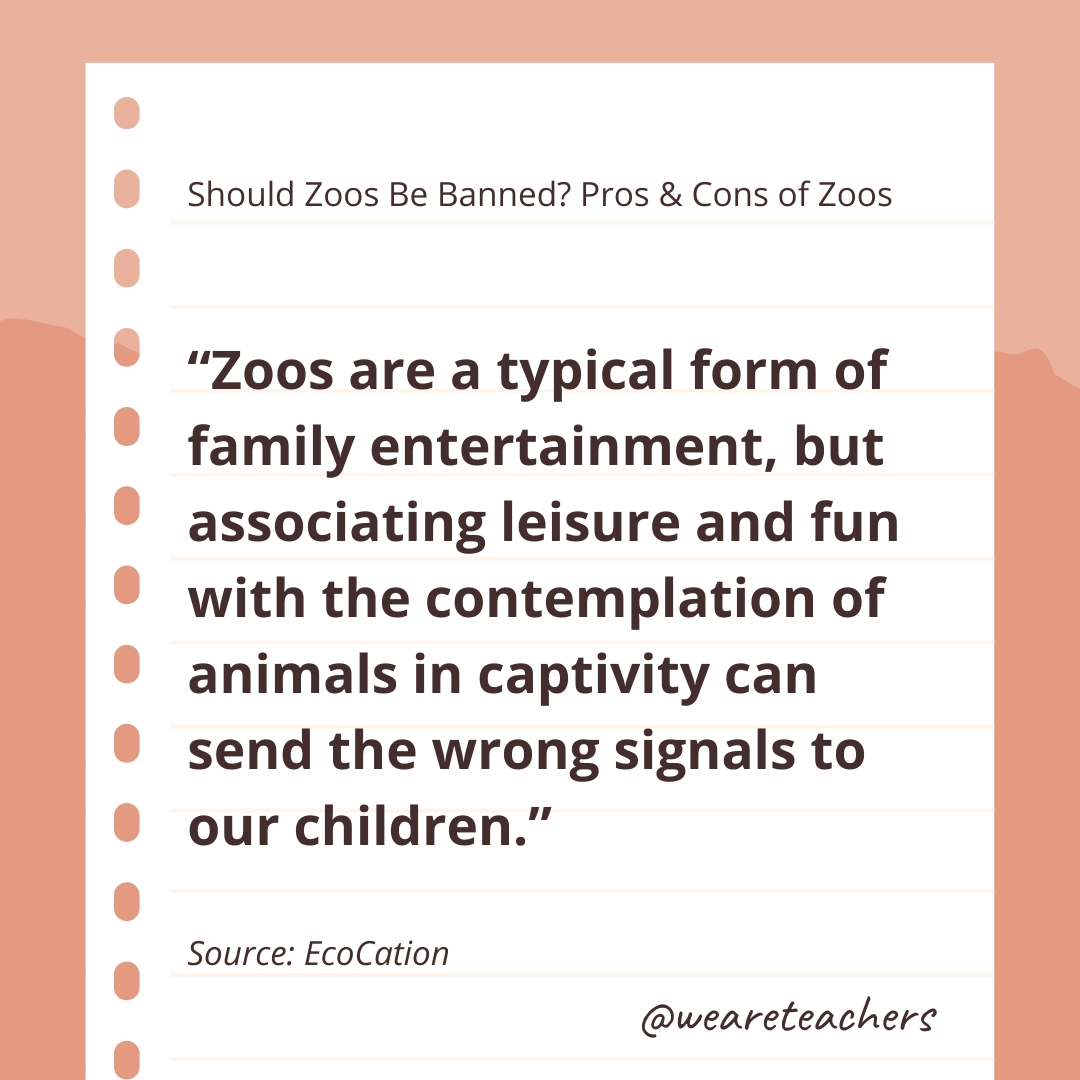
Sample lines: “The pros and cons of zoos often come from two very different points of view. From a legal standard, animals are often treated as property. That means they have less rights than humans, so a zoo seems like a positive place to maintain a high quality of life. For others, the forced enclosure of any animal feels like an unethical decision. … Zoos provide a protected environment for endangered animals, and also help in raising awareness and funding for wildlife initiatives and research projects. … Zoos are key for research. Being able to observe and study animals is crucial if we want to contribute to help them and repair the ecosystems. … Zoos are a typical form of family entertainment, but associating leisure and fun with the contemplation of animals in captivity can send the wrong signals to our children.”
Read the full essay: Should Zoos Be Banned? Pros & Cons of Zoos at EcoCation
Do you have a favorite compare and contrast essay example? Come share in the We Are Teachers HELPLINE group on Facebook .
Plus, if you liked these compare and contrast essay examples check out intriguing compare and contrast essay topics for kids and teens ..
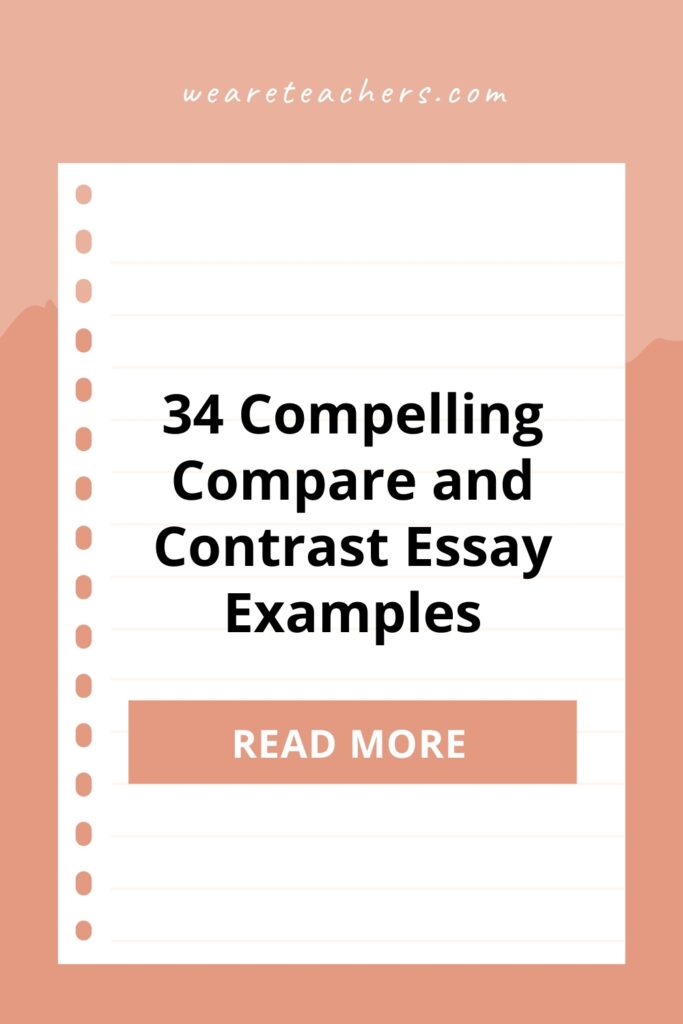
You Might Also Like
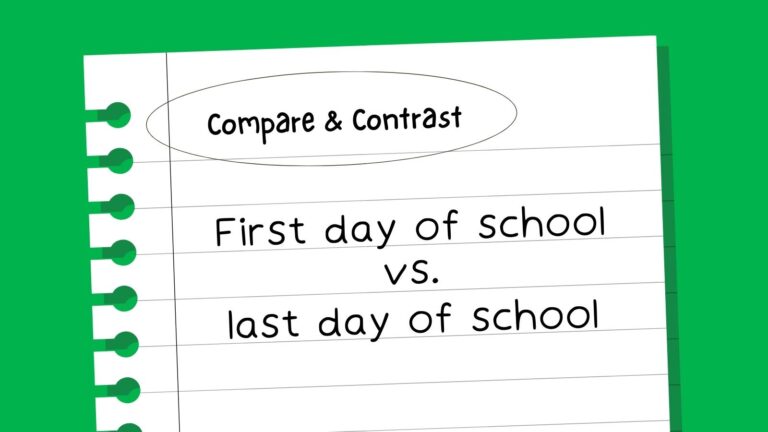
125 Intriguing Compare and Contrast Essay Topics for Kids and Teens
Android vs. iPhone? Capitalism vs. communism? Hot dog vs. taco? Continue Reading
Copyright © 2024. All rights reserved. 5335 Gate Parkway, Jacksonville, FL 32256

COMMENTS
In this guide, we explain how to write a compare-and-contrast essay, including some advanced tips and examples. We discuss how to structure your essay and how to frame your thesis, but first, let’s take a broader look at …
Learn how to effectively structure and write compare and contrast essays to showcase similarities and differences between two or more subjects, enhancing your analytical skills and essay-writing proficiency.
Learn the essential steps and tips on how to write a compelling comparison essay that effectively compares and contrasts two or more subjects to help you excel in your academic writing.
This handout will help you first to determine whether a particular assignment is asking for comparison/contrast and then to generate a list of similarities and differences, decide which similarities and differences to focus on, and organize …
Always address both subjects of your essay in any introductions, conclusions, and topic sentences. Use comparison words and phrases such as “similarly,” “like,” and “in the same way” when comparing subjects. Use …
To write a good compare and contrast essay, it’s best to pick two or more topics that share a meaningful connection. The aim of the essay would be to show the subtle differences or unforeseen similarities.
A compare and contrast essay example can be an opinion piece comparing two things and making a conclusion about which is better. For example, “Is Tom Brady really the GOAT?” It can also help consumers decide …